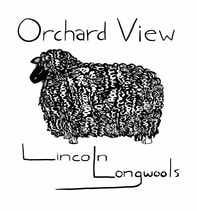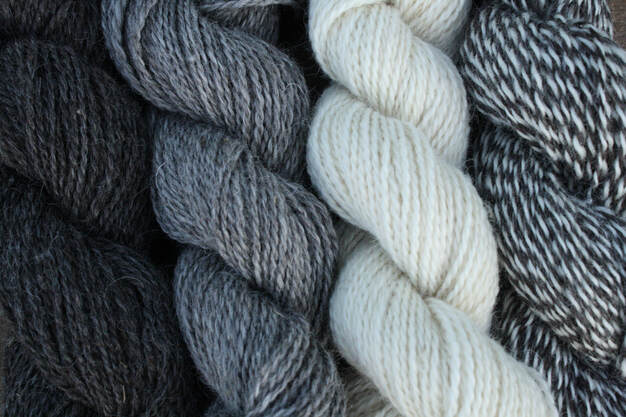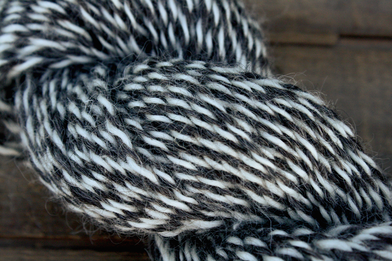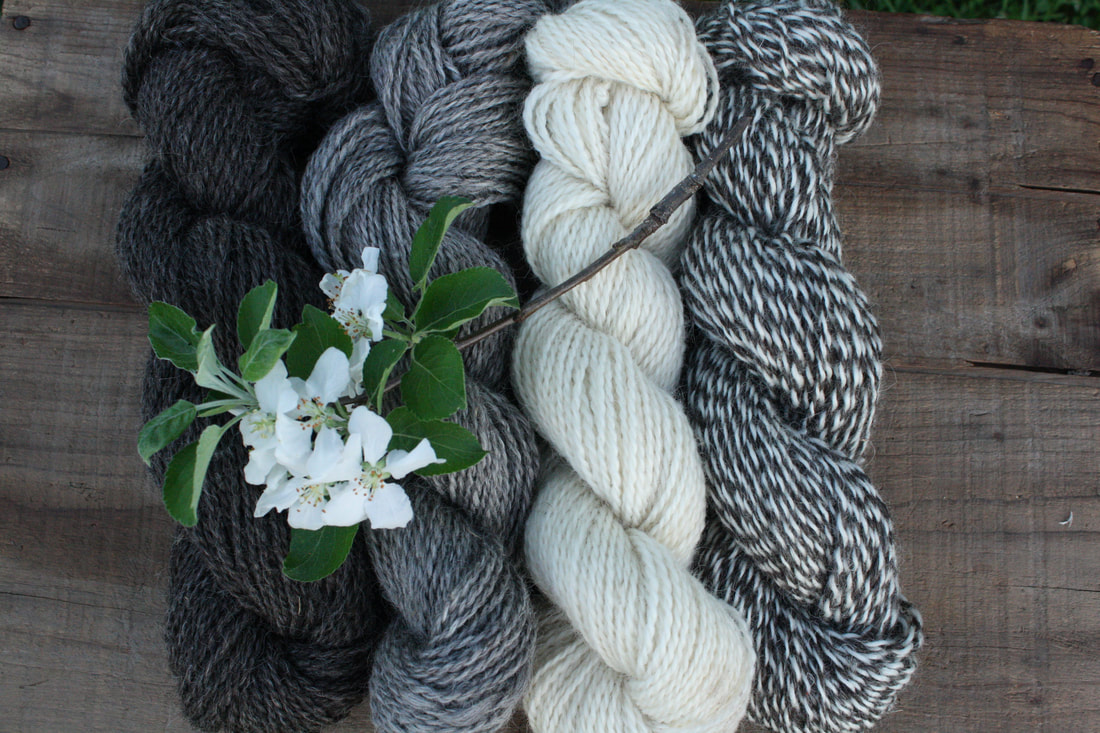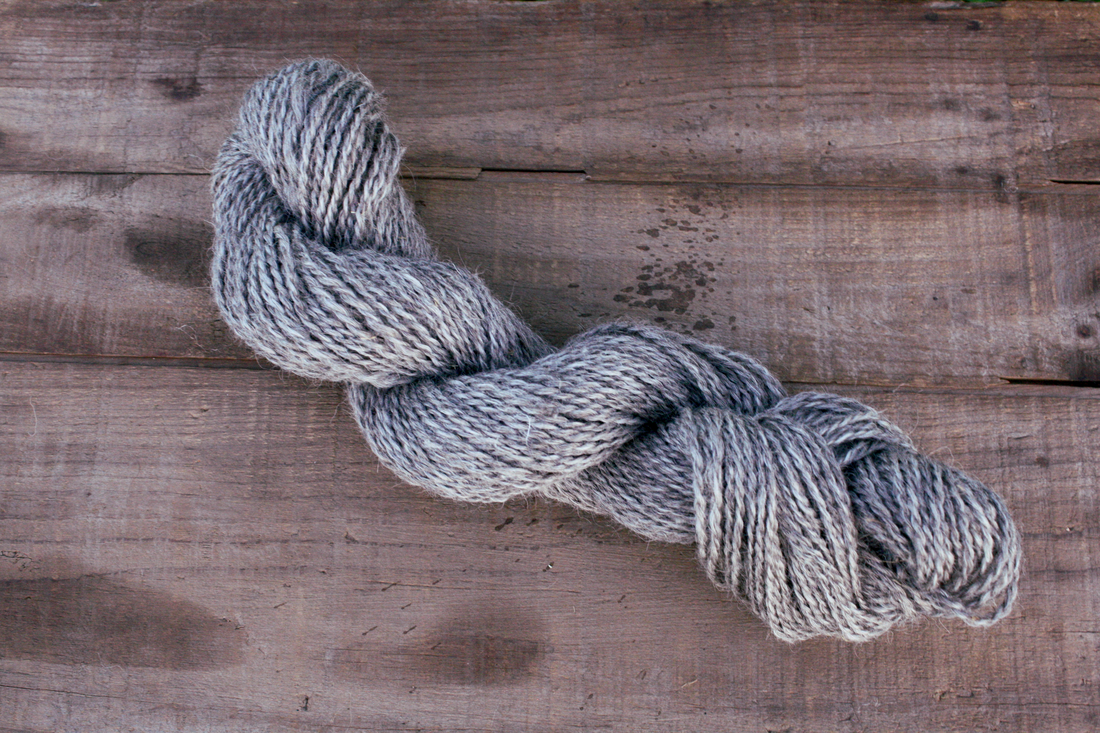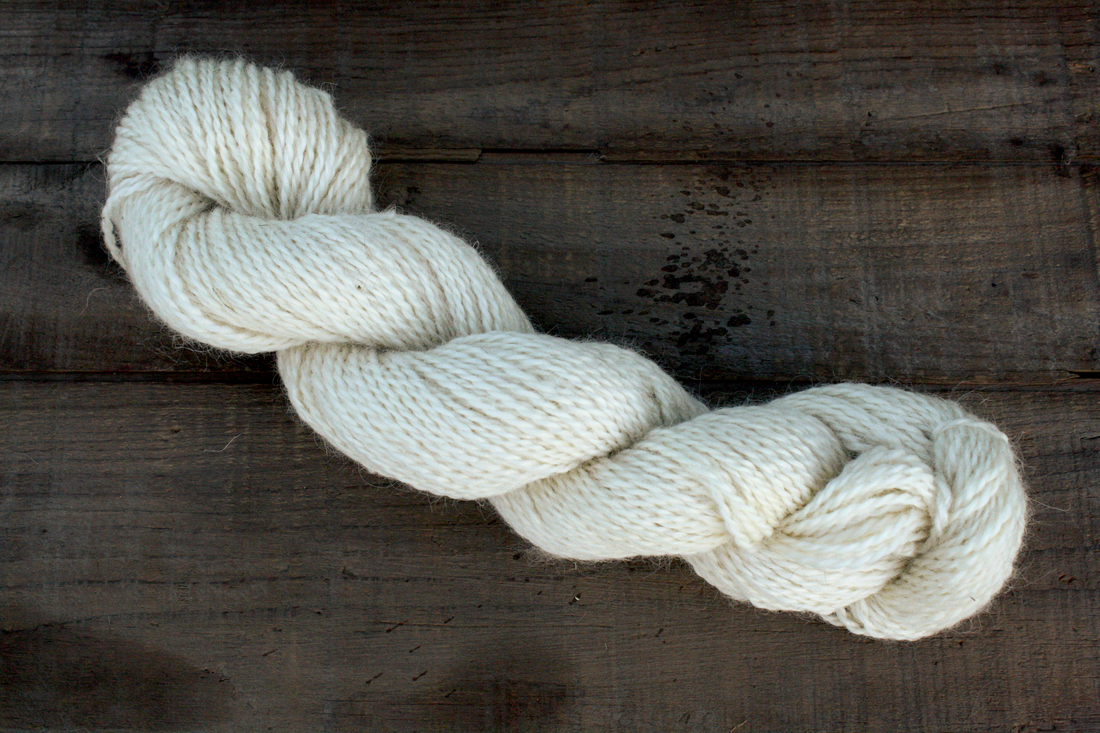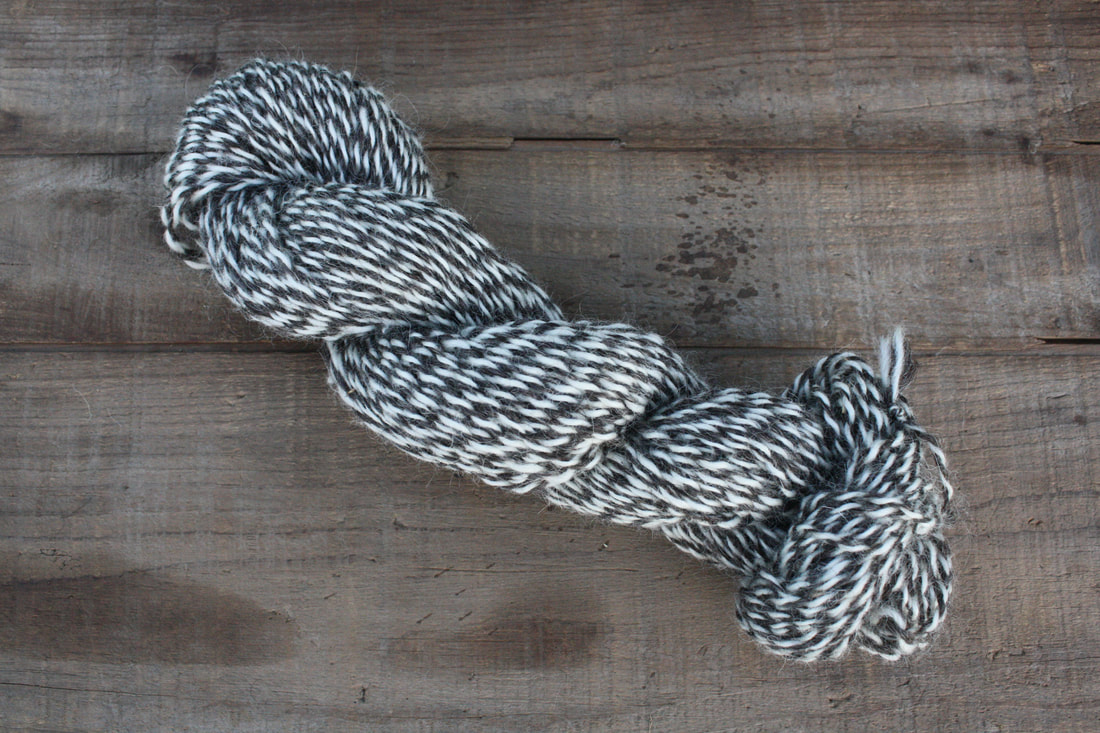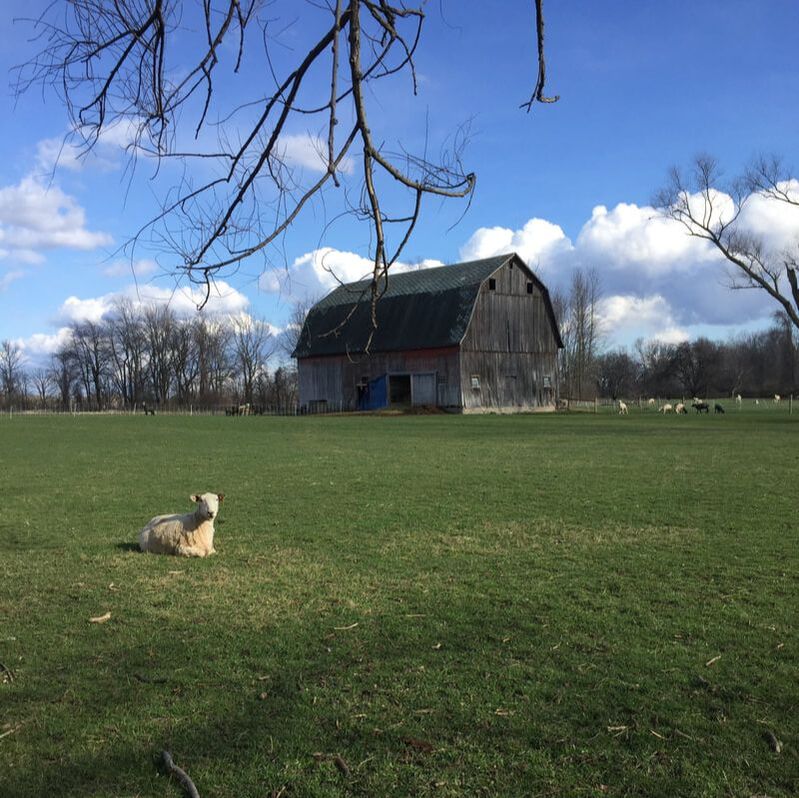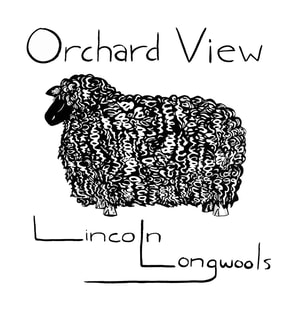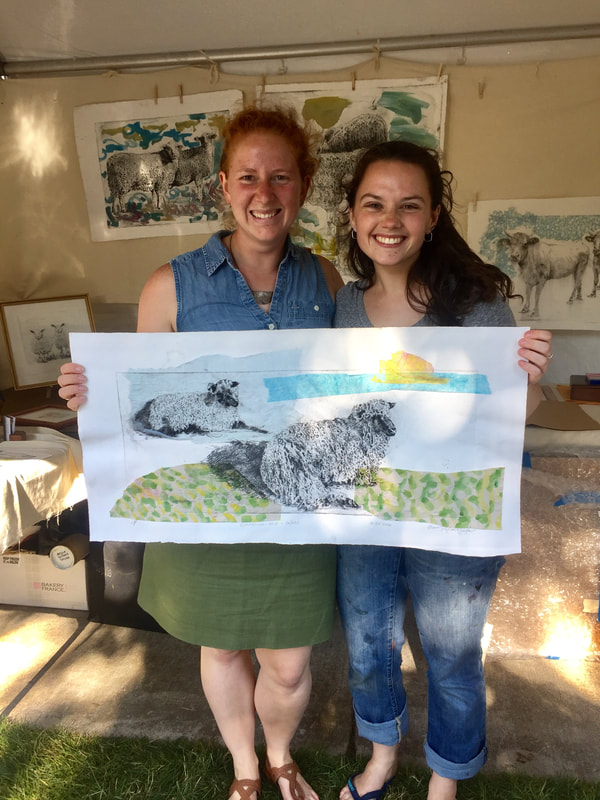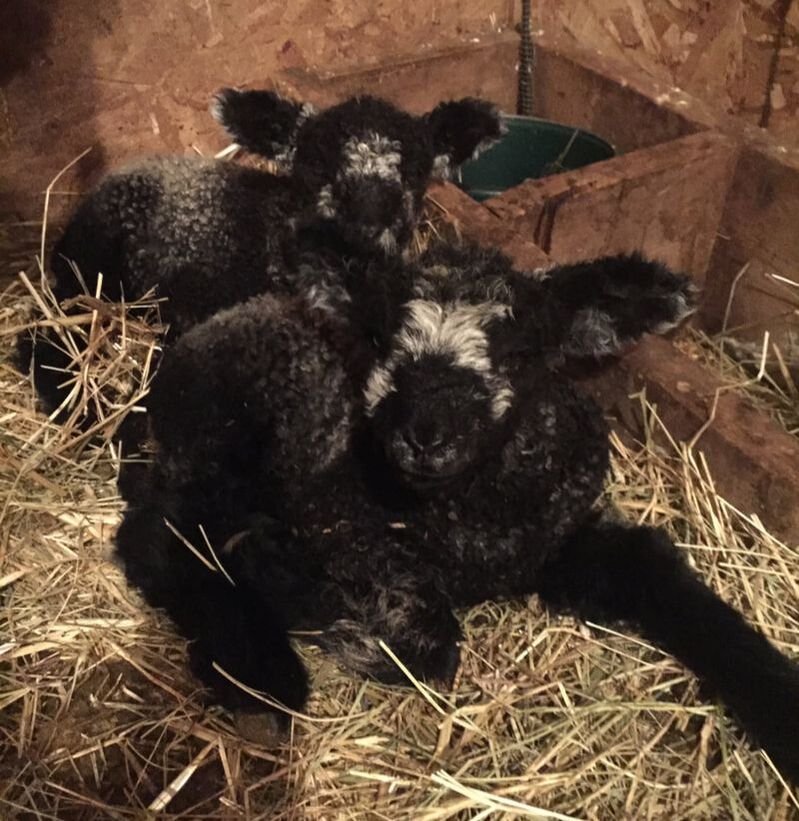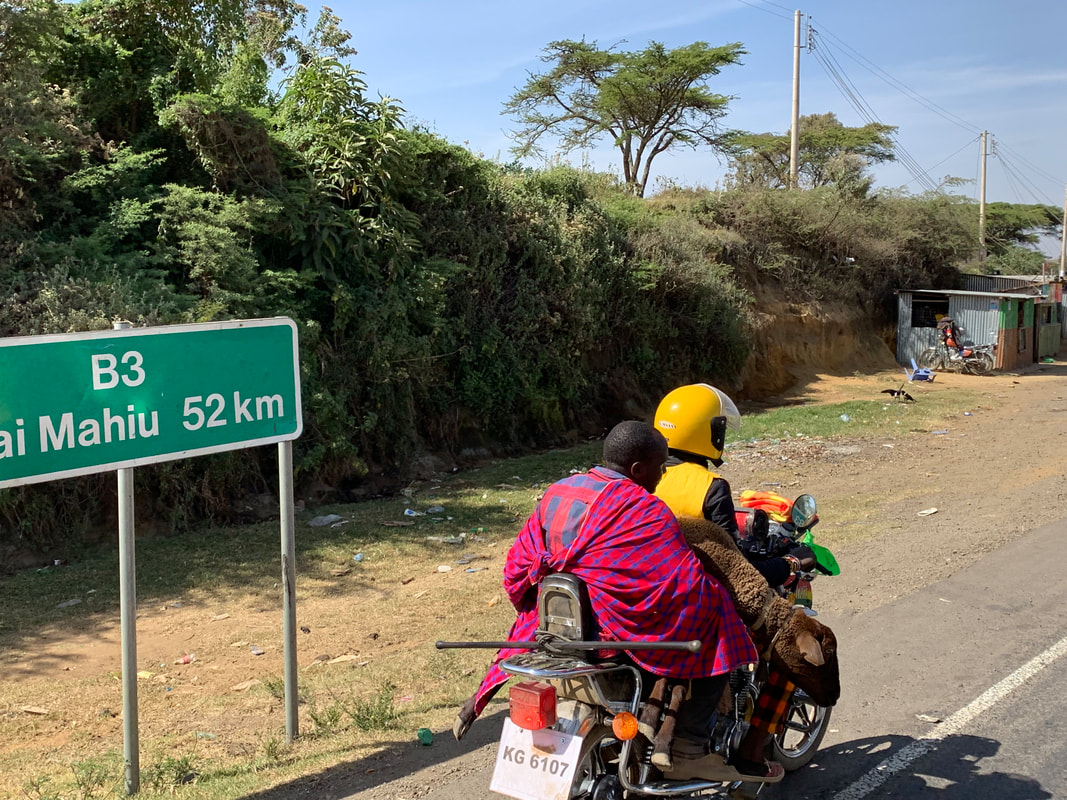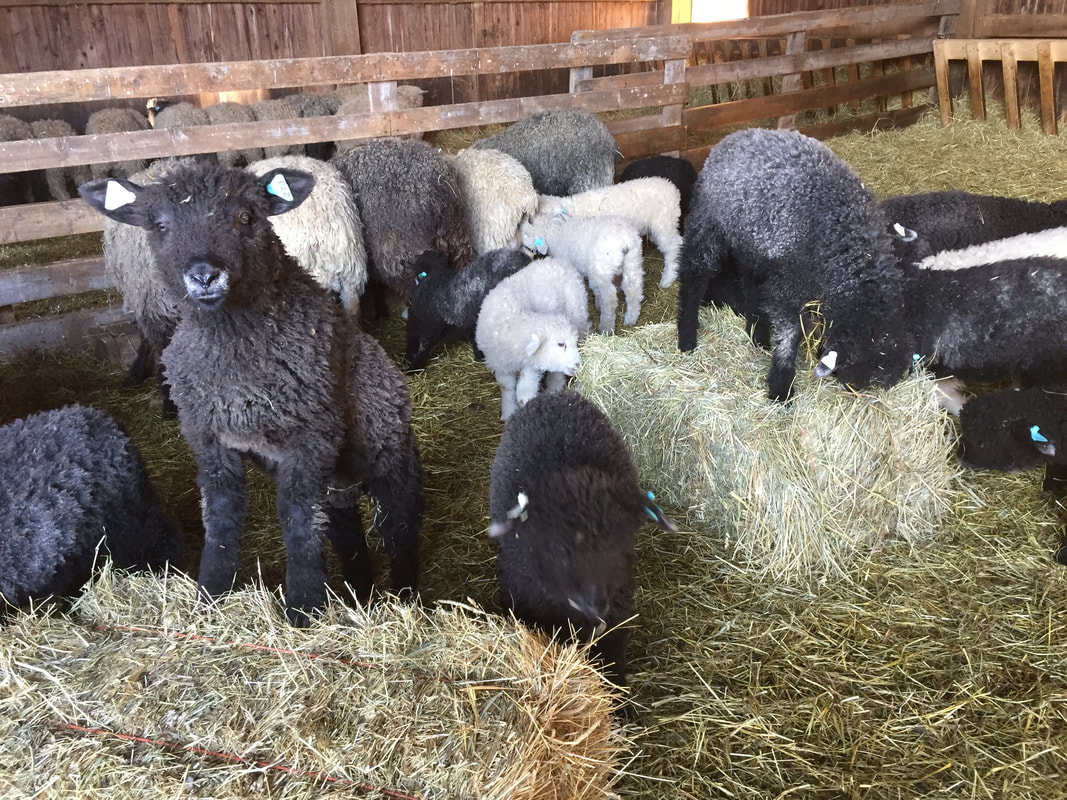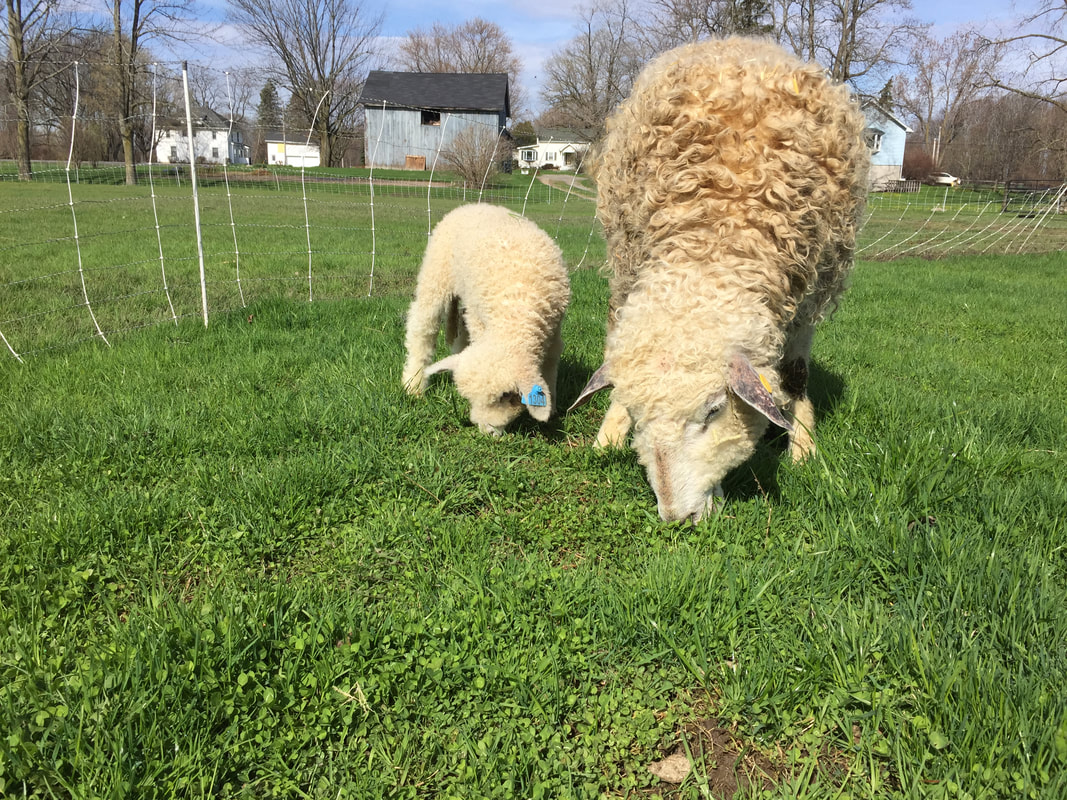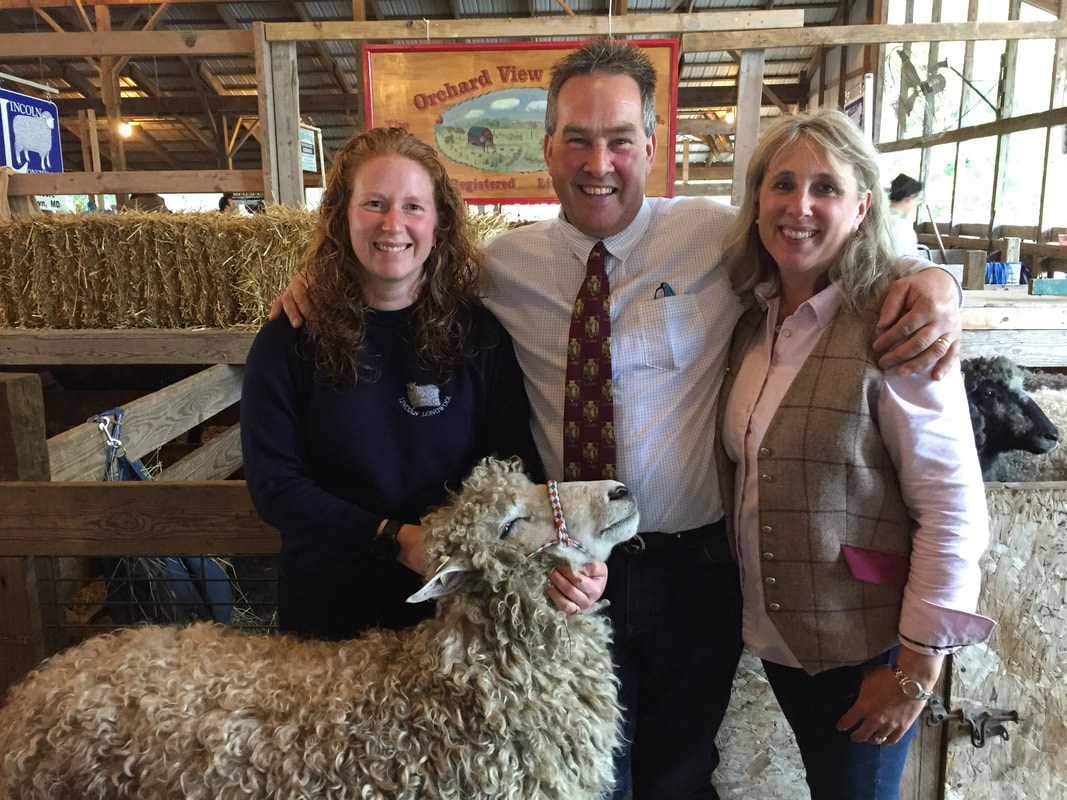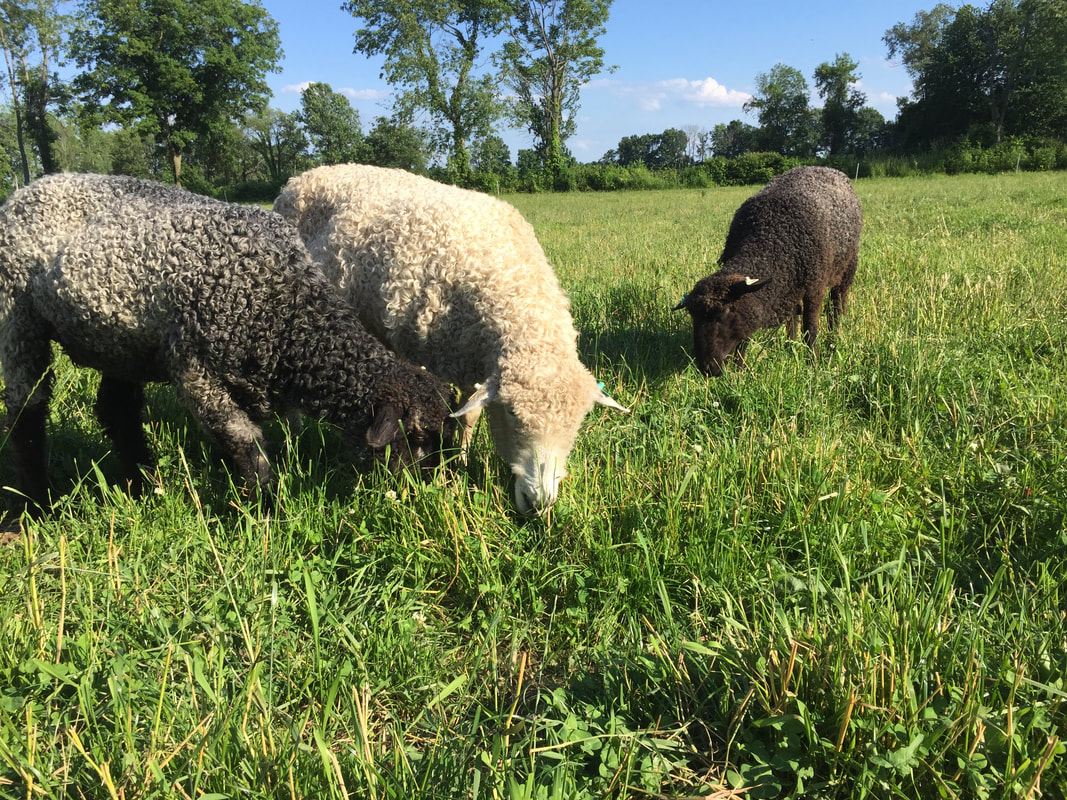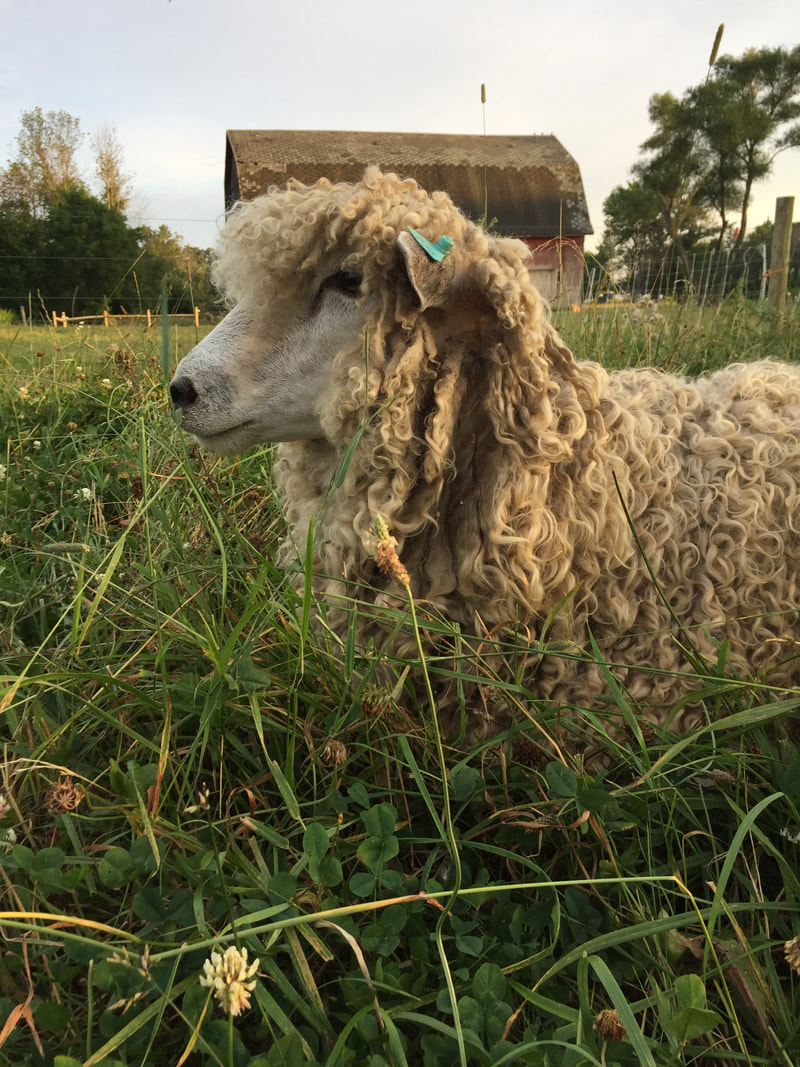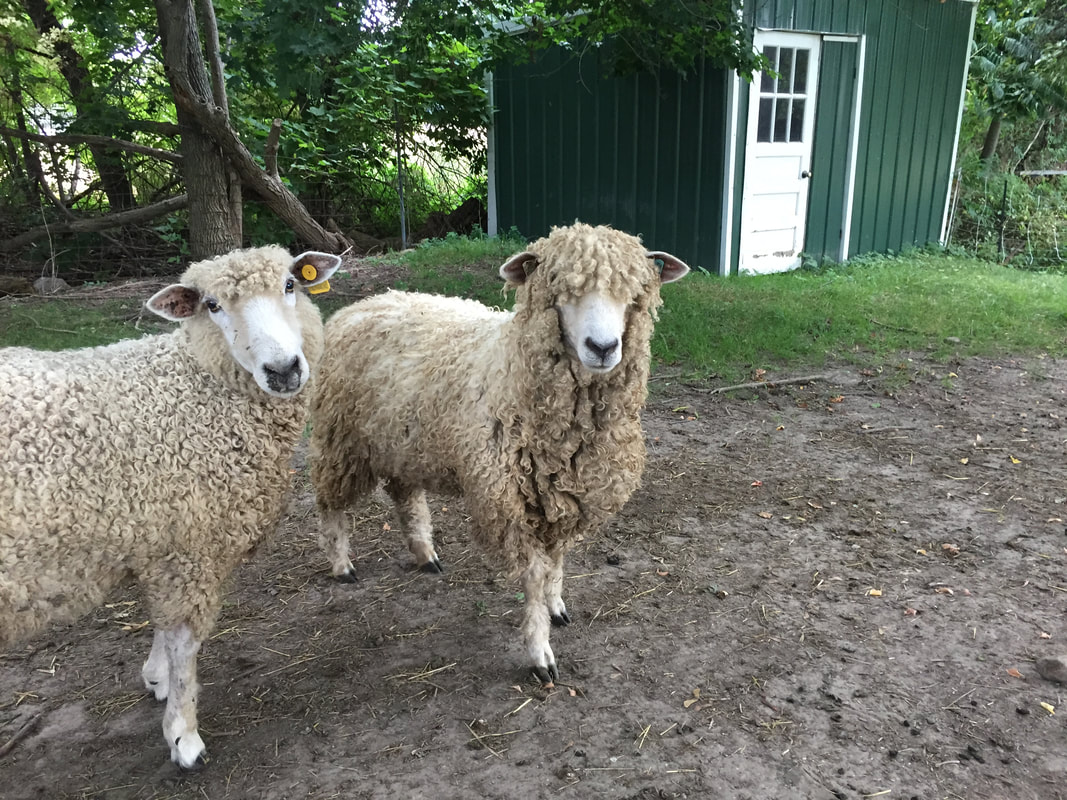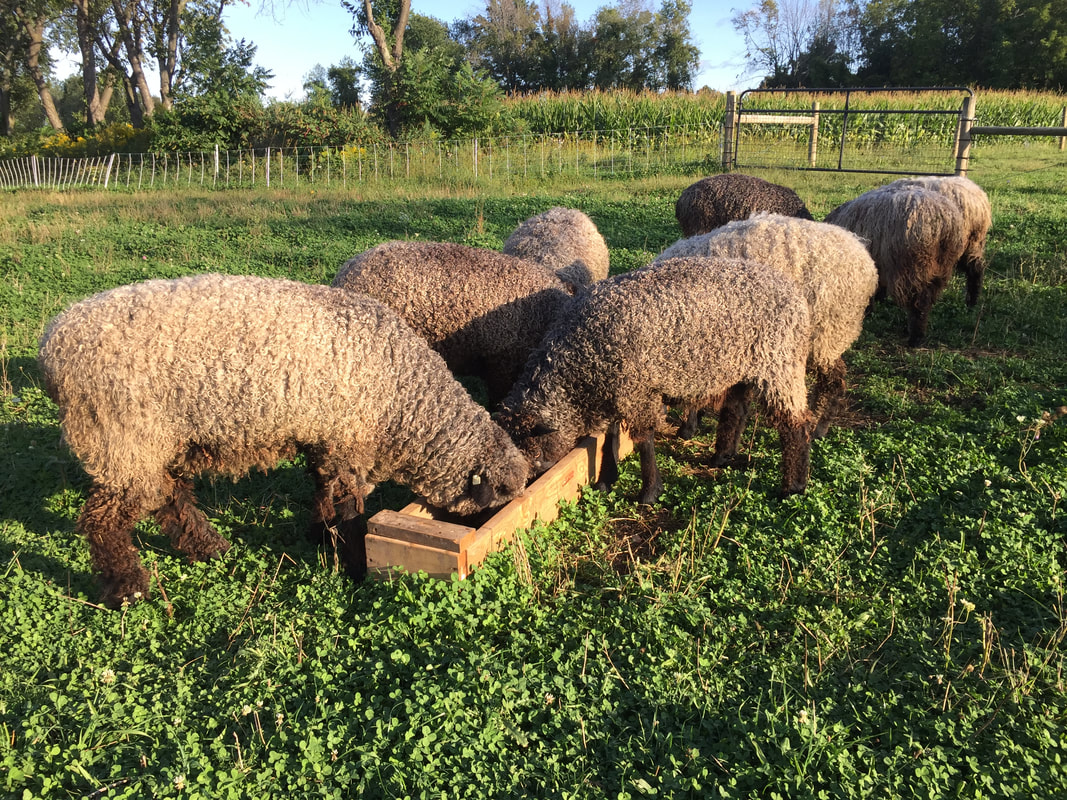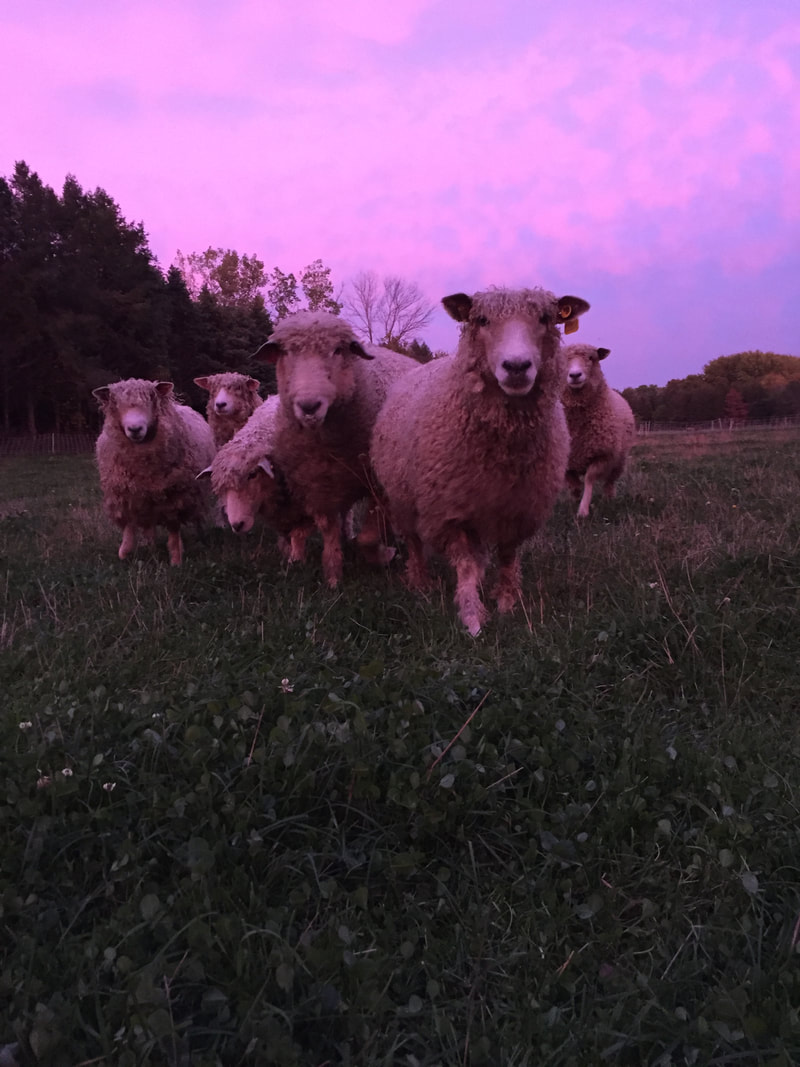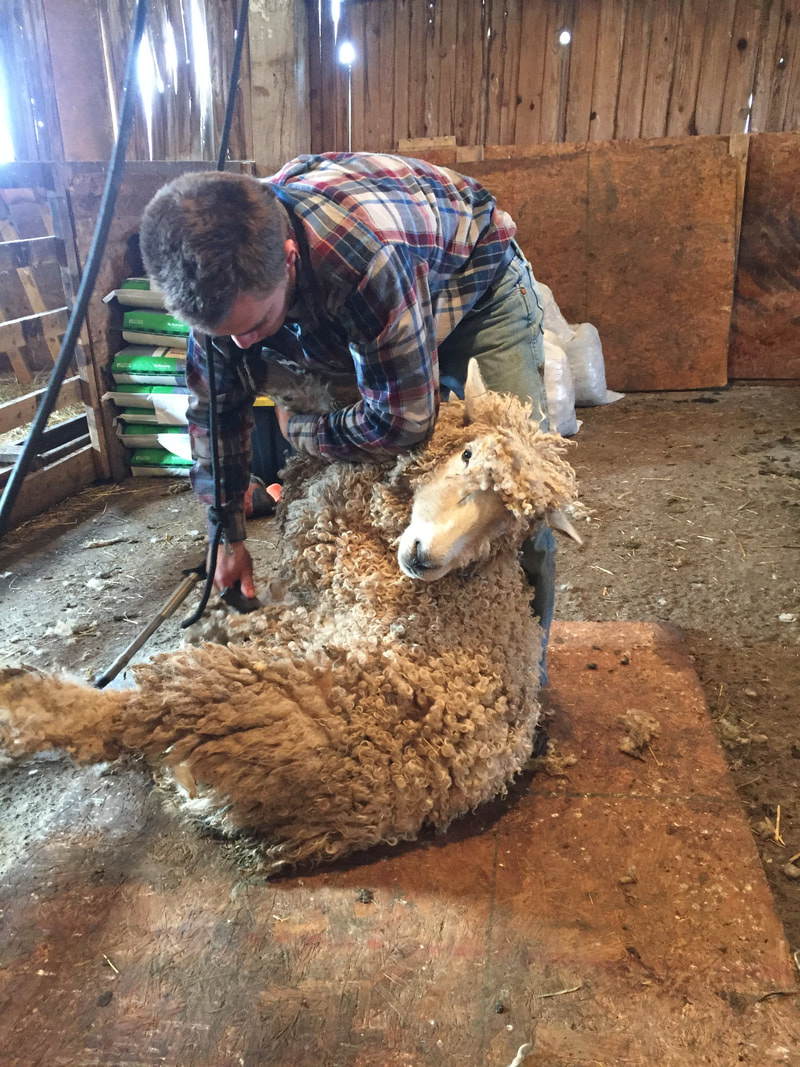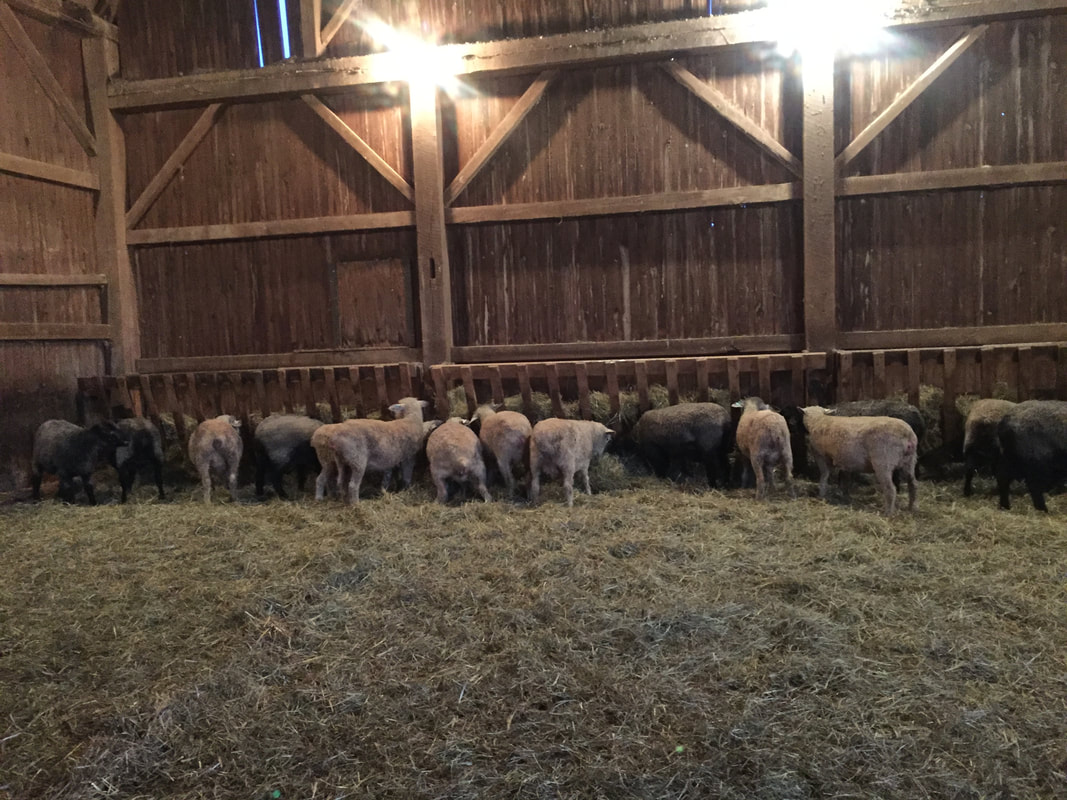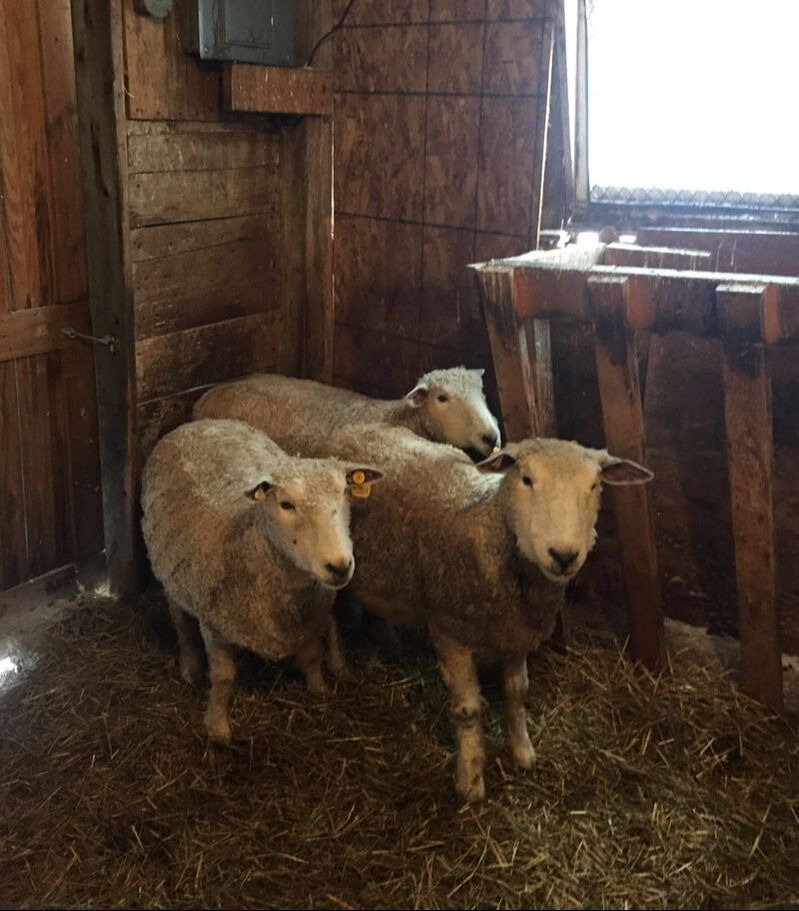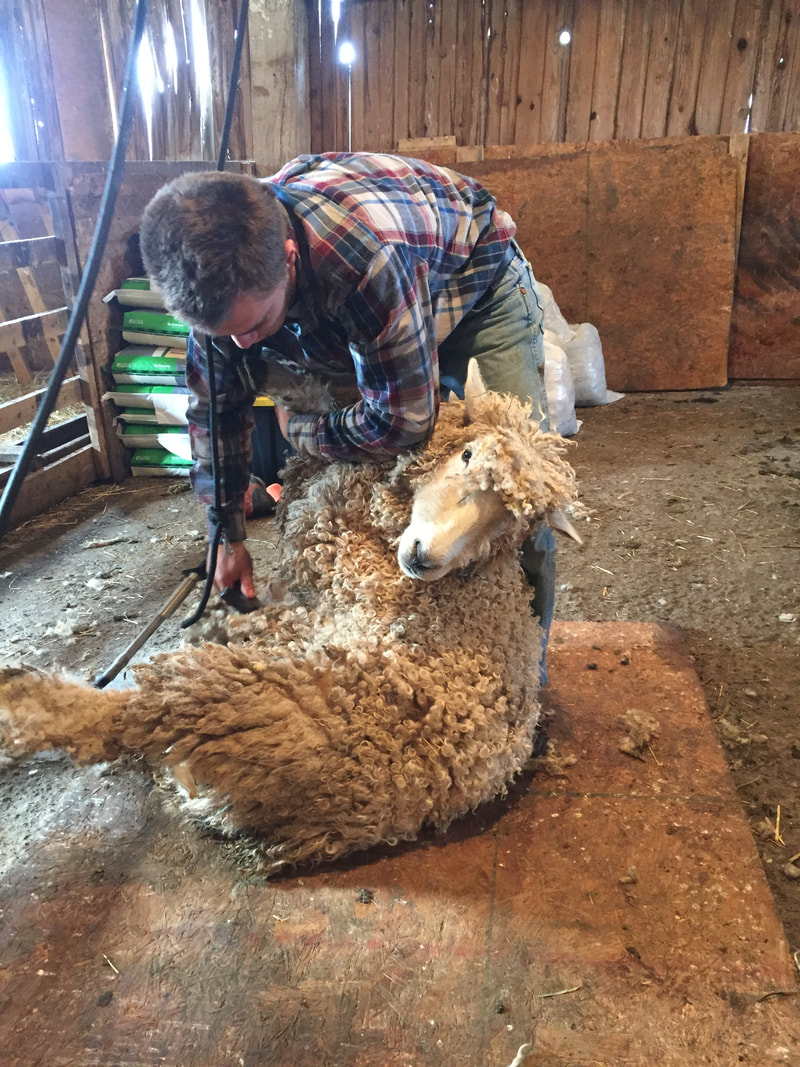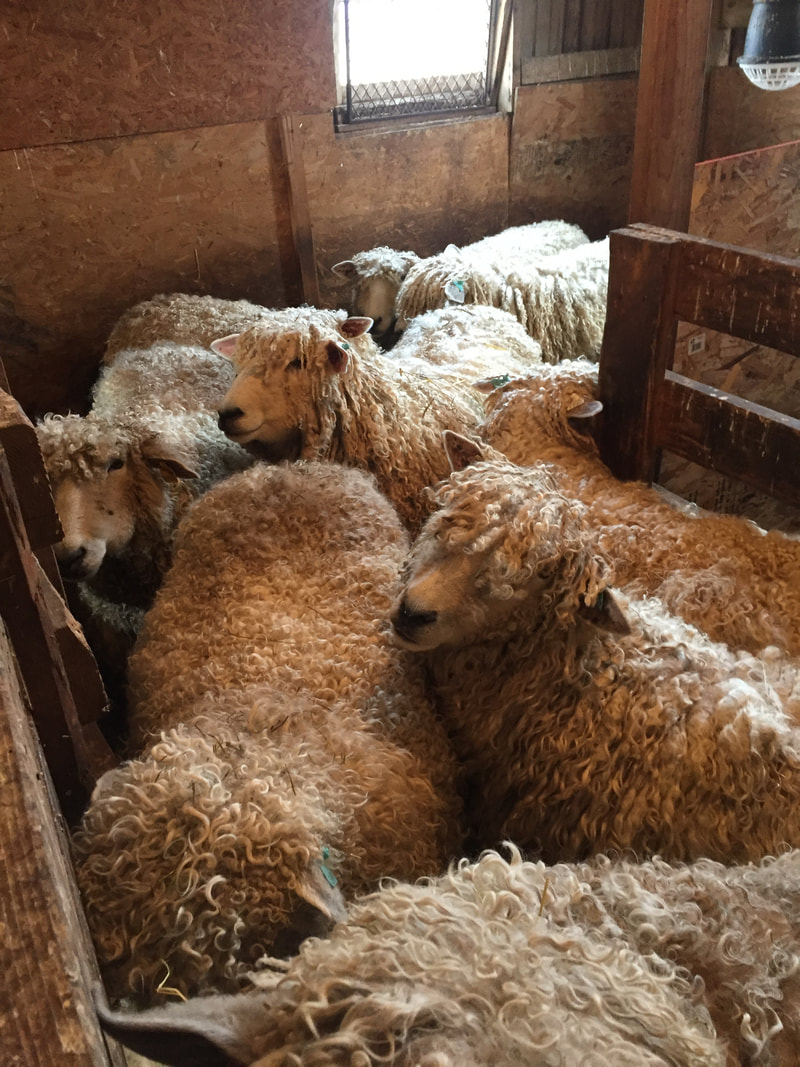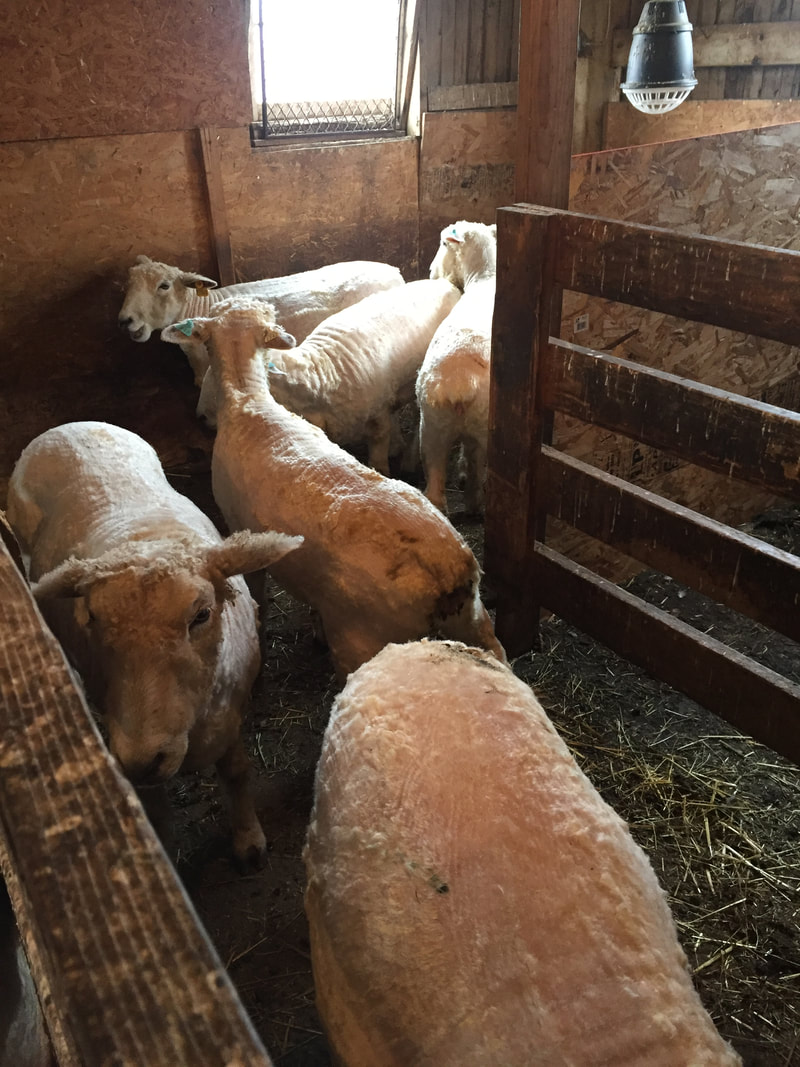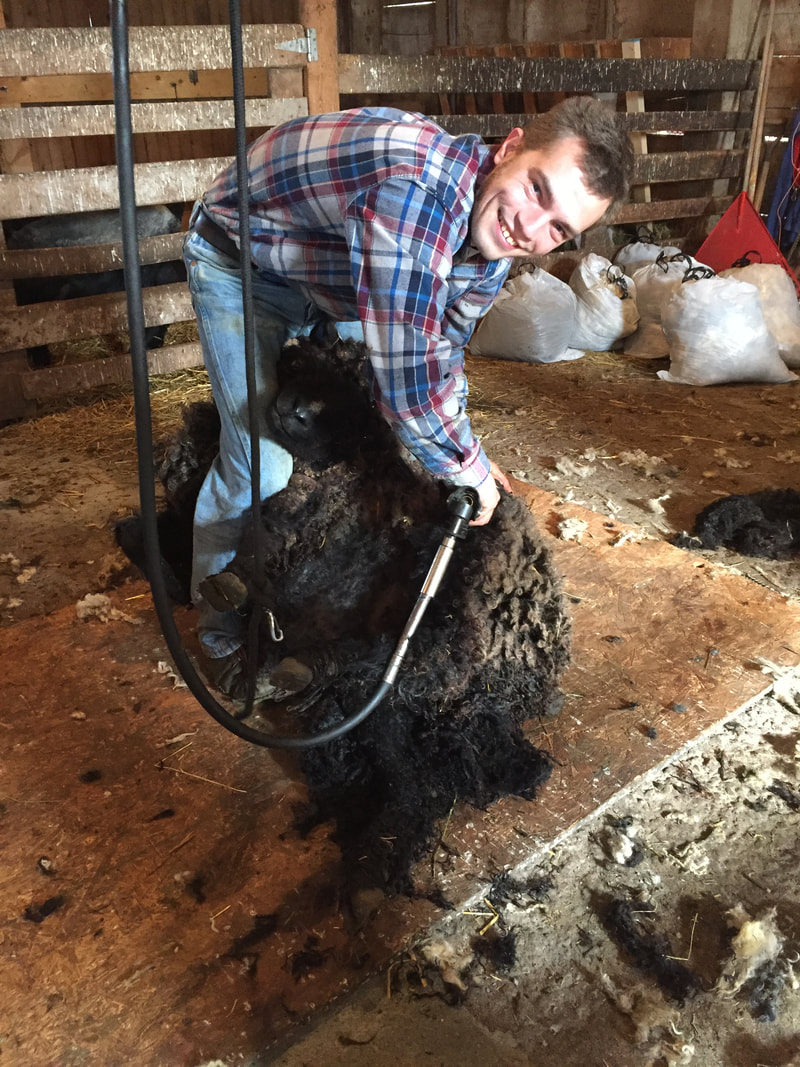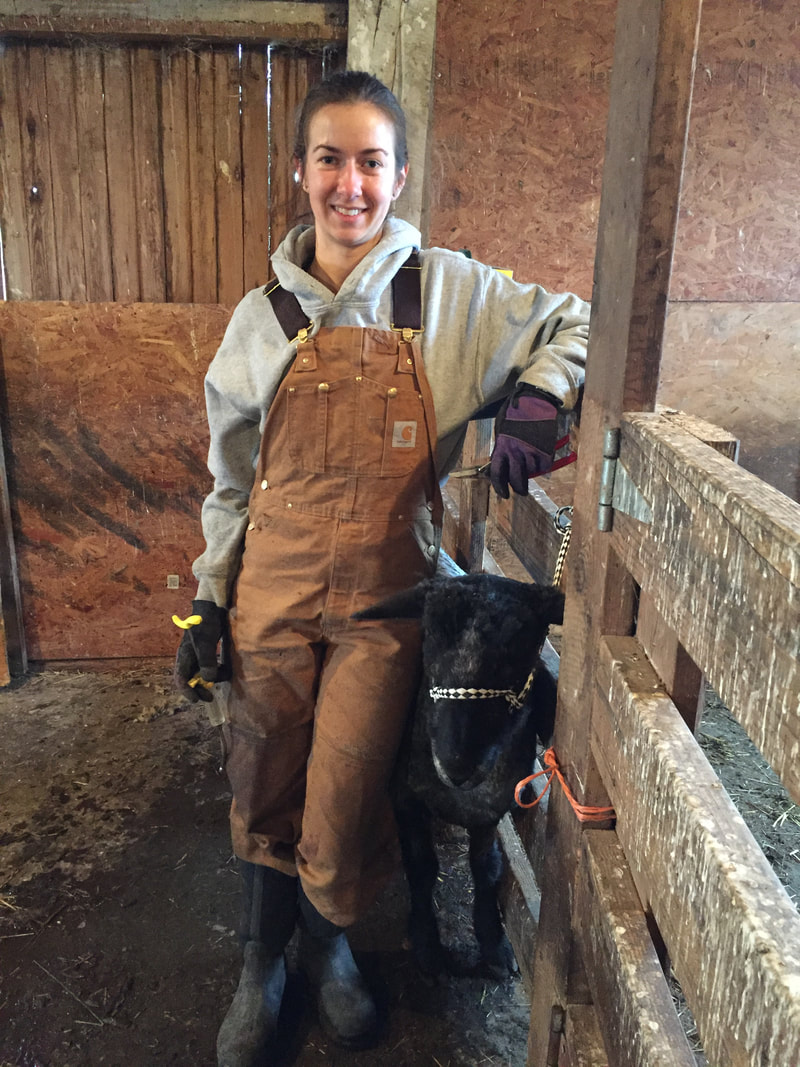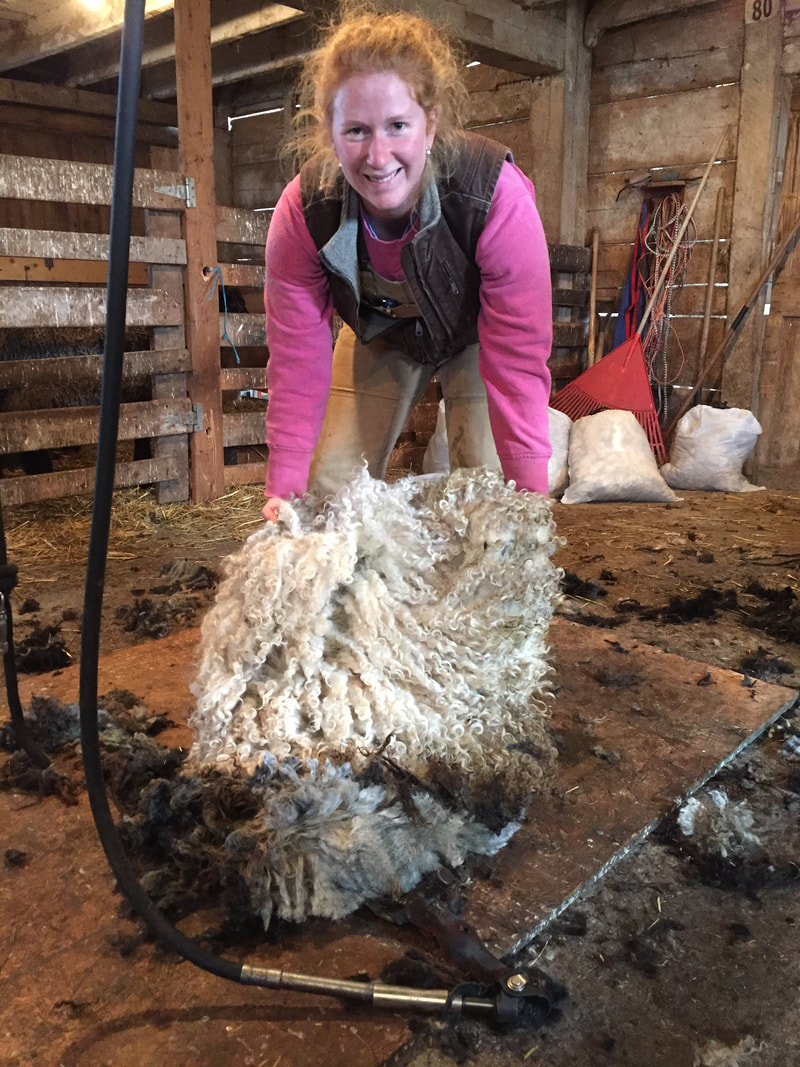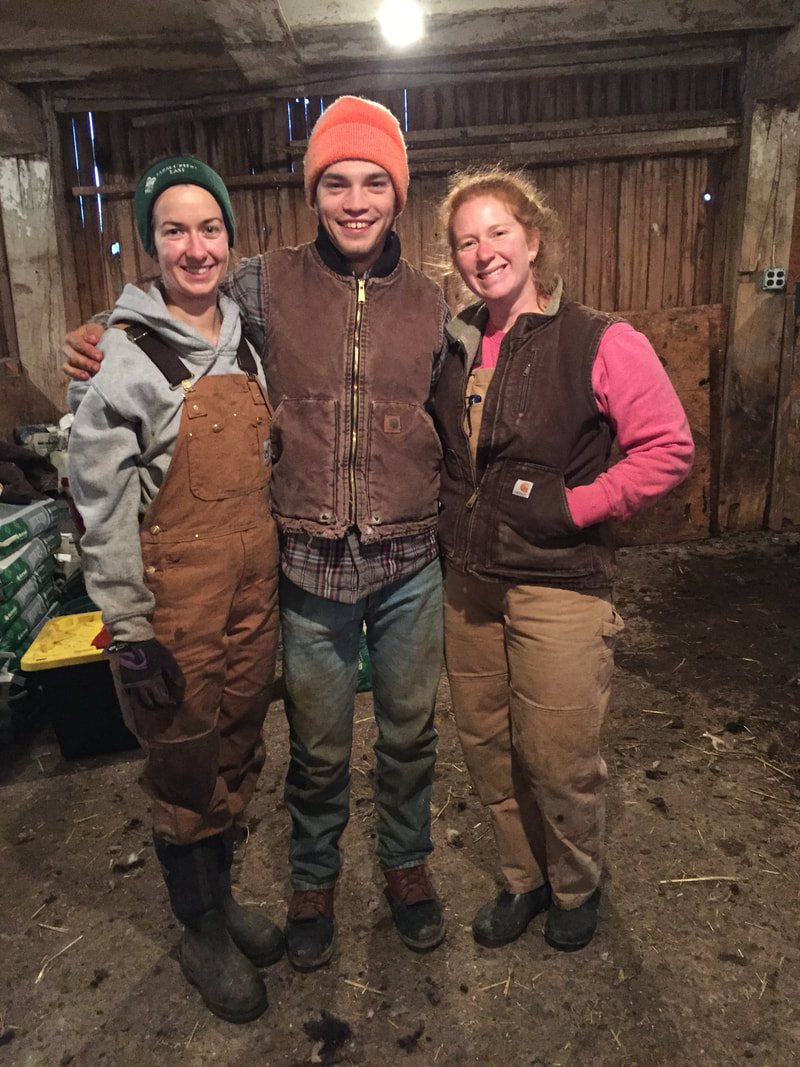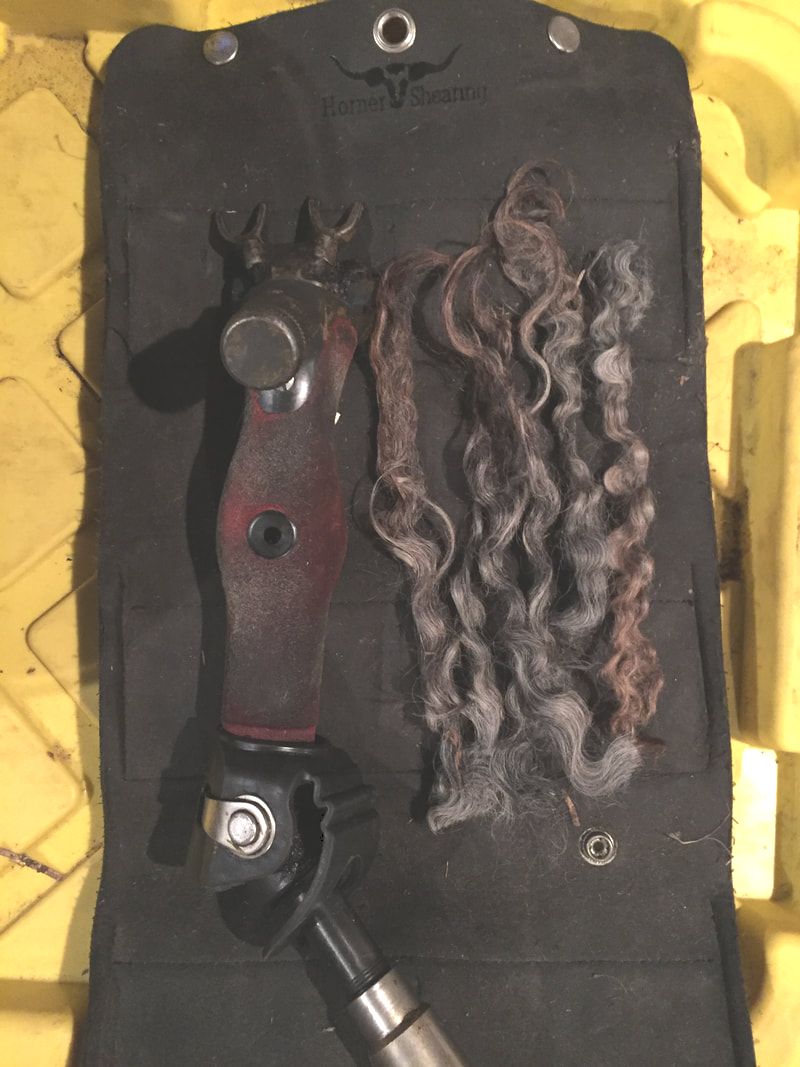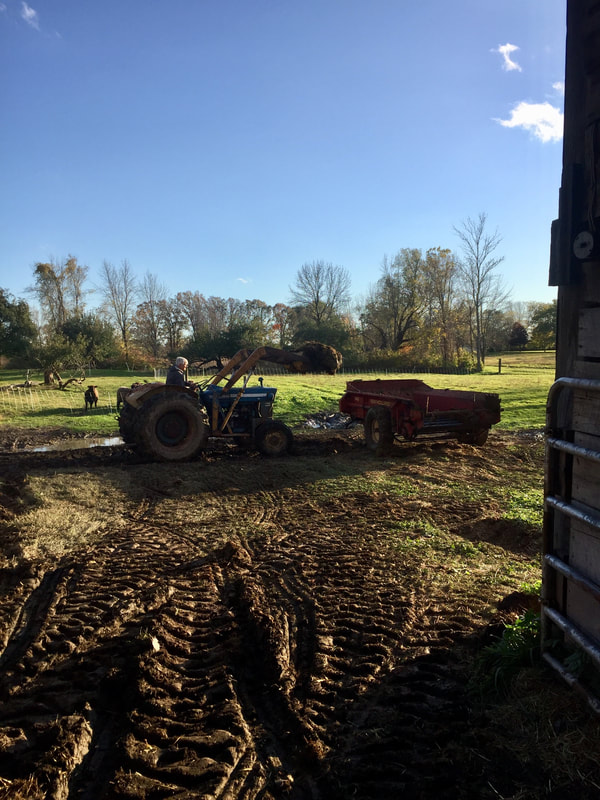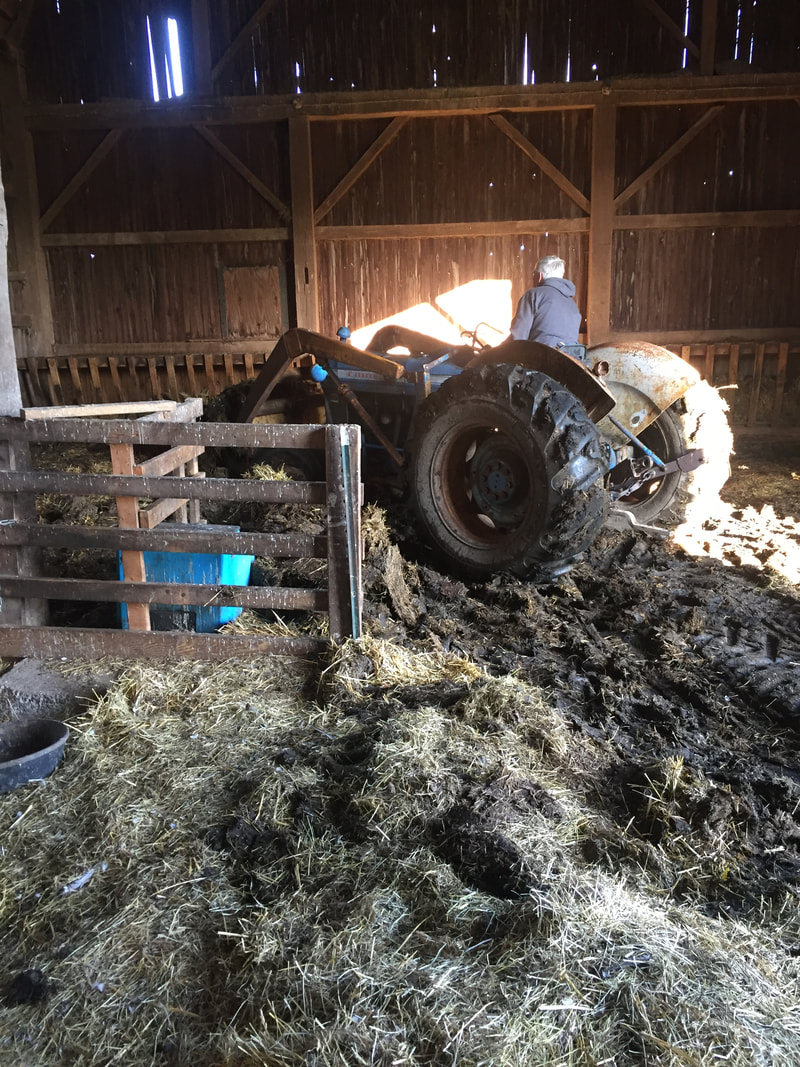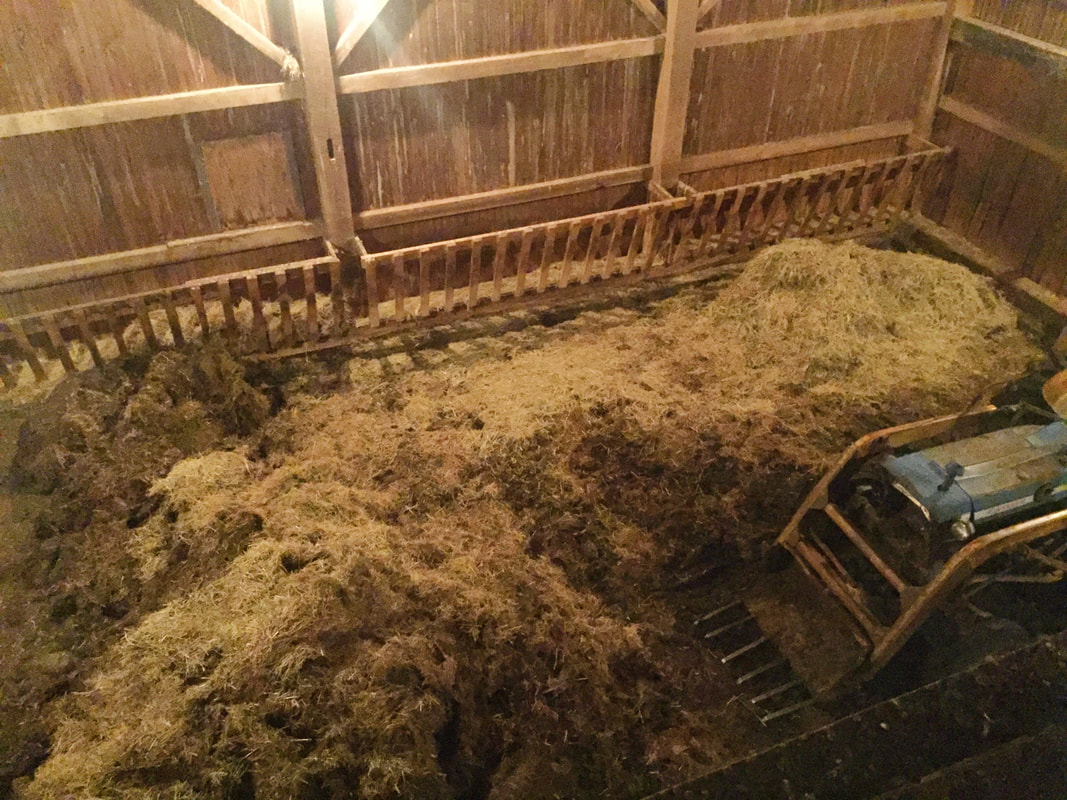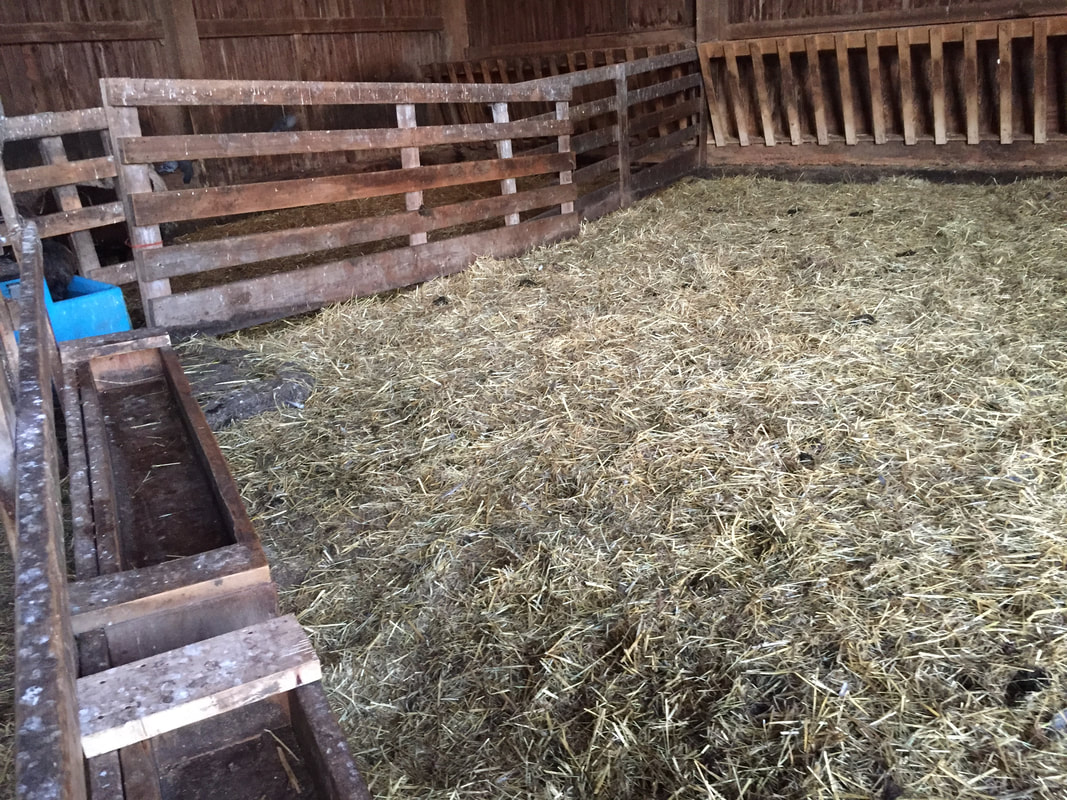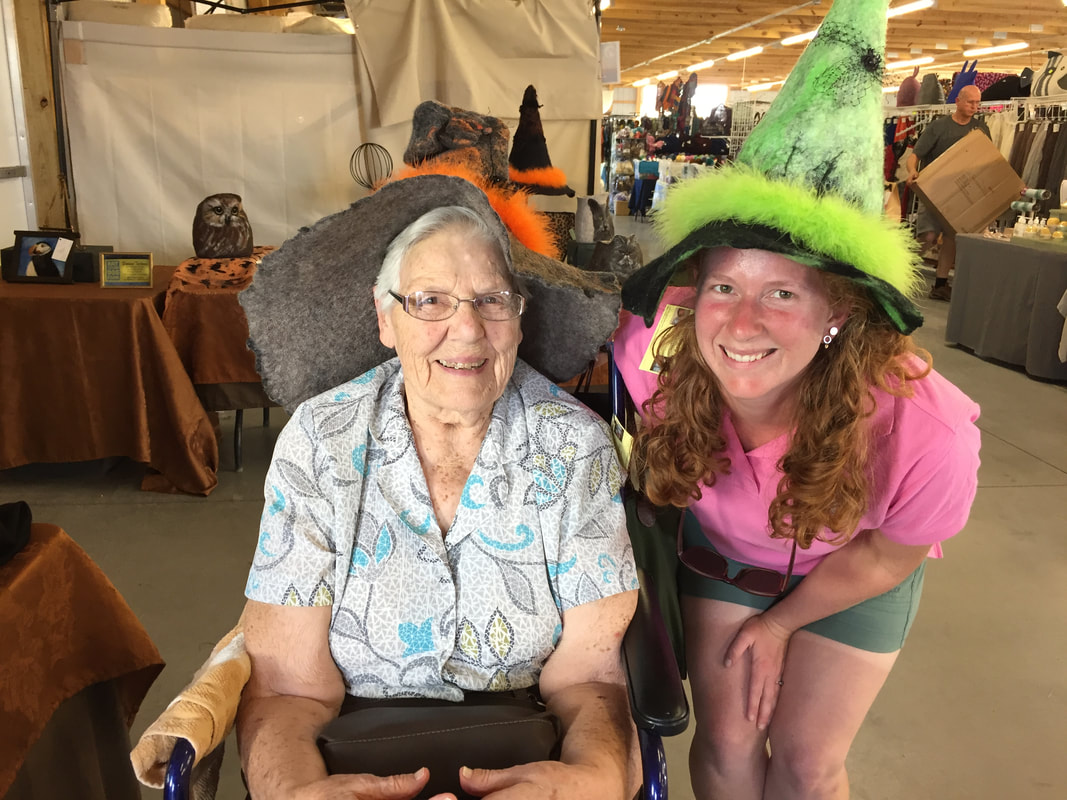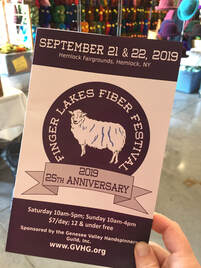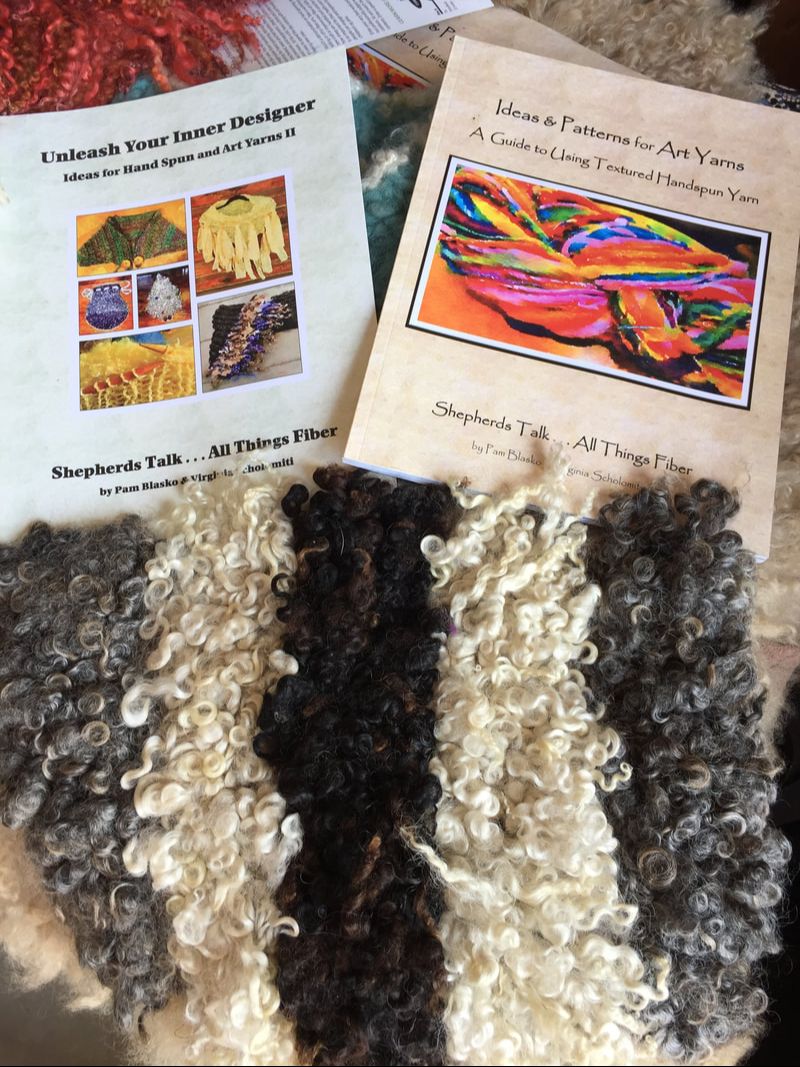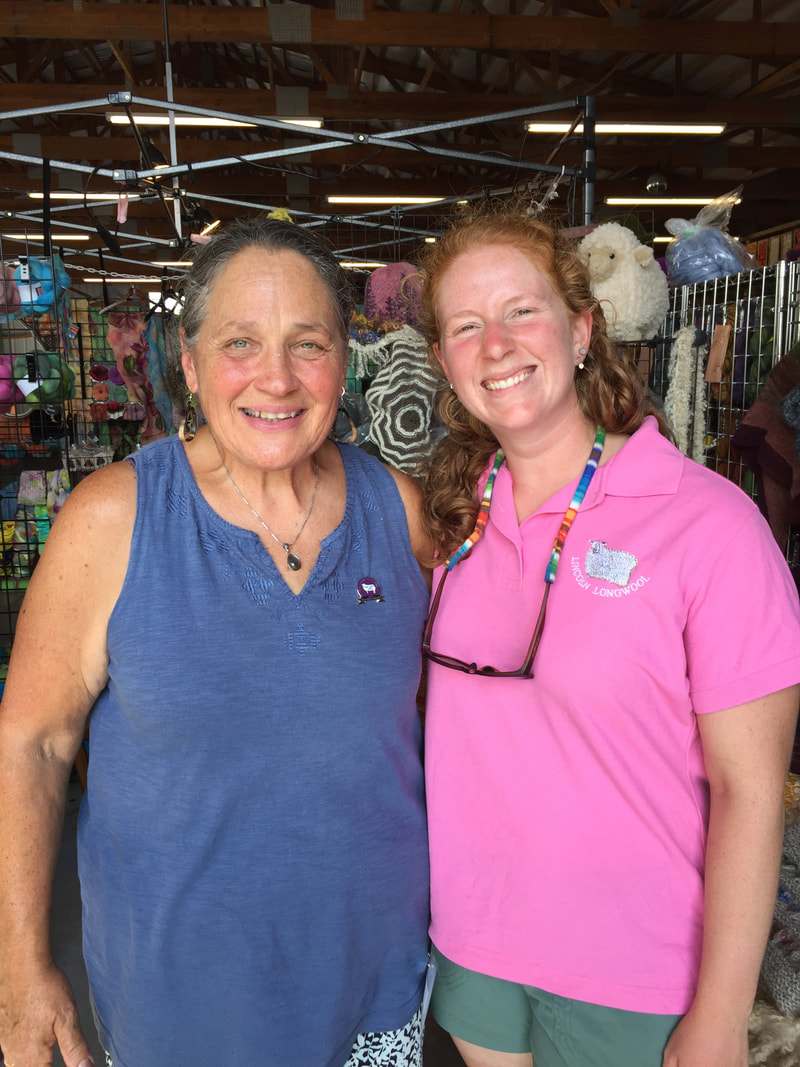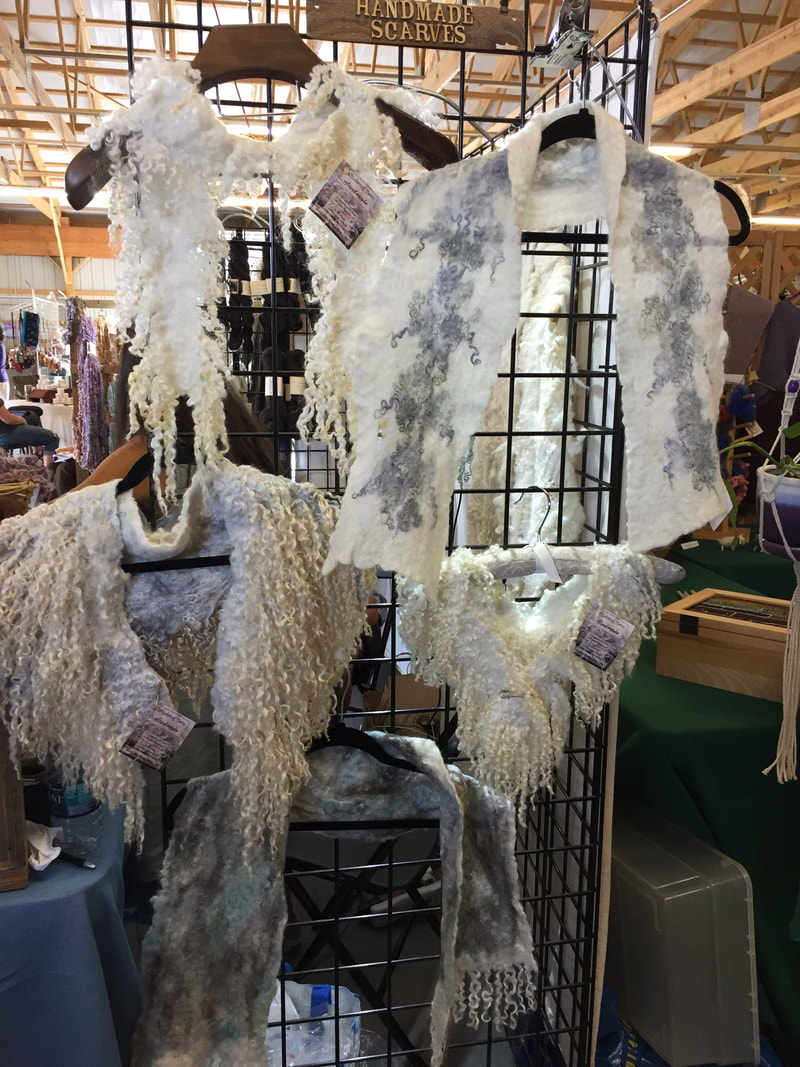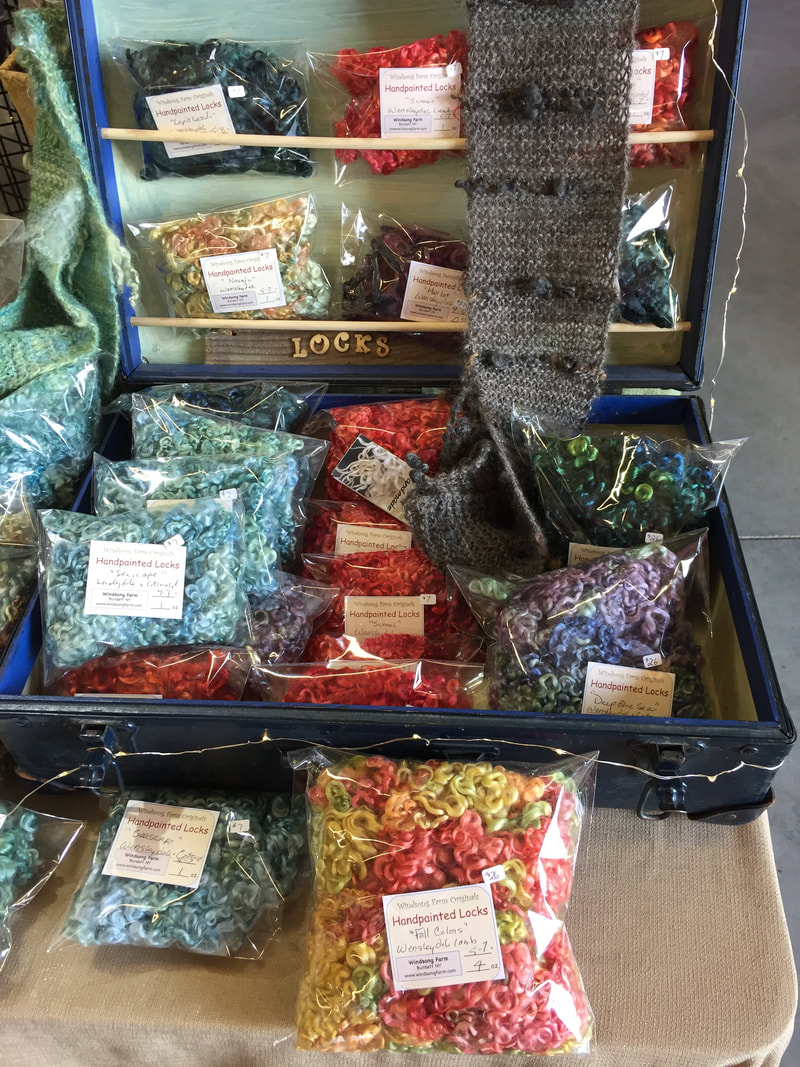|
I'm back after a busy summer, and with exciting news! Last year I released my first ever flock yarn, Empire DK, and was completely blown away by the response! It was such a leap of faith for me to do, but the first lot sold out in less than a year. After many messages of positive feedback and gorgeous photos of knitwear, I thought it was time to introduce another line of yarn to the Orchard View Collection, McIntosh Aran. Like Empire, McIntosh is 100% Lincoln Longwool from my flock. Battenkill Fiber Mill did such a beautiful job on Empire, I knew I wanted her help with this yarn also to continue keeping the whole process of flock to yarn in NY. McIntosh is a 2-ply aran weight yarn that is made with fleece from my mature ewes, making it a little more rustic than Empire, which is made using lamb's wool. It has the same beautiful luster as Empire, but more structure. 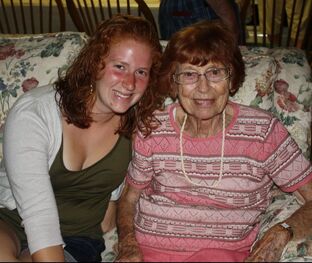 She's also where my red hair came from! She's also where my red hair came from! eIf you remember my post about Empire last year, there was a reason I chose that name and there's a story behind this yarn's name also. I decided years ago that if I ever created my own lines of yarn, they would be named after apple varieties, specifically apple varieties that were developed in NY. In my research about the McIntosh apple variety, I discovered that it actually wasn't discovered in NY, but nearby the St. Lawrence River in Ontario, CA by a man named John McIntosh. Interestingly, Mr. McIntosh was born in the Mohawk Valley region of Central NY shortly after the Revolutionary War and moved to Canada as a young man. So... still a NY connection! He discovered the apple growing wild on his farm and transplanted a few trees to his garden and the McIntosh apple was born. More importantly than being an apple variety, McIntosh is a connection to Grandma Smith, my maternal grandmother. Grandma's maiden name was McIntosh and several of our family members have collected apple-themed things over the years because of the name. Grandma Smith was very crafty and loved to sew. It's only fitting to have a yarn named after her, as I think much of my love for crafting came from her. Each 4 oz skein of McIntosh Aran is approximately 165 yds and comes in four colors: charcoal, silver, white and marl. Contact me if you're interested in trying this new flock yarn! It is available through myself (hopefully soon you'll be able to purchase directly on my website), and also at Lift Bridge Yarns in Fairport, NY and Prado de Lana in Stockbridge, MA. As always, I love feedback on my yarns and seeing what people are create with my wool.
1 Comment
6:00am- Feed the bottle lambs, fill water buckets, give grain to the lambs, fill hay racks
5:00pm- Evening chores Shear the sheep, check fences, clean pens, prep fleece orders. These are normal chores. Normal routines. Normality with myself and my flock. Right now, normality is an illusion. The world right now is not normal. Things have changed. We struggle to source our preferred brand of grain because the feed store cannot get reliable shipping. My favorite weekend of the year, the Maryland Sheep and Wool Festival, has been cancelled. Prospective buyers of my lambs who were interested in starting flocks are not returning calls. Life as a shepherd, though seemingly so on the daily, has not remained the same. The sheep continue their daily grazing, blissfully unaware of how the world has changed around them. Still, we are thankful. We are thankful that I work for a farm where we can source a little bit of whole corn to stretch the grain a little longer. We are thankful for social media that allows us to continue to interact with fiber customers. We are thankful for a steady market for our lambs with the local Arab community... even though I'd rather they go to breeding stock than meat. I keep reminding myself that it's ok to be upset about the things that aren't going as planned, but I also keep reminding myself that this is temporary. The struggles of my small flock pale in comparison to other peoples' situations. Warmer weather is coming and we won't need to feed grain in a few weeks. Maryland will be back next year. Lambs will find homes soon enough. I hope that you, your families and your flocks are healthy and safe! Last year about this time, I wrote a post about my favorite sheepy books and thought I would add a couple additional ones to that list that I plan to read this year. What is on your flock/farm/fiber reading list for this year? Vanishing Fleece: Adventures in American Wool- Clara Parkes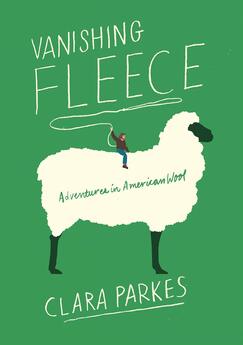 This book has been on my reading list since it first came out and my amazing sister got it for me for Christmas, not even knowing that I wanted it! It has been all over social media in the fiber world, as Clara Parkes does an amazing job with telling the narrative of fiber. The author purchases a 600+ lb bale of wool and follows the process as it is transformed into yarn and documents the people and process along the way. I'm very excited to dig into this one! Fibershed: Growing a Movement of Farmers, Fashion Activists, and Makers for a New Textile Economy- Rebecca Burgess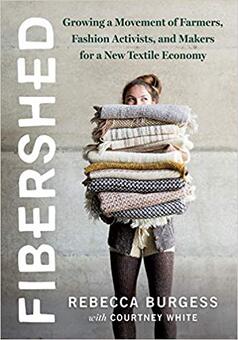 This book has been on my to-read list as well and was gifted to me by MaryJeanne of Battenkill Fibers over the holidays. Just like Clara Parkes, Rebecca Burgess is a bit of a celebrity in the fiber world. She is the brains of the original fibershed concept and movement in Northern California where has been working to connect ranchers, farmers, and artisans with the end user to encourage wearing clothing made from fiber grown, woven and sewn in her area. Adventures of the Yorkshire Shepherdess- Amanda Owen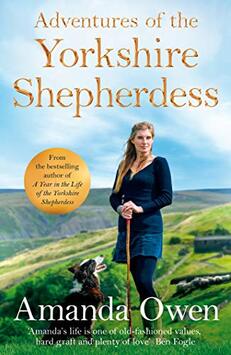 I mentioned Amanda's books last year and this one is her newest that came out in 2019. Her books chronicle her and her family's lives managing a flock of sheep in the remote hill country of England. They are full of tales that are reminiscent of James Herriot, only more remote! I have enjoyed her writing and look forward to adding this one to my collection. Managing Your Ewe and Her Lambs- Laura Lawson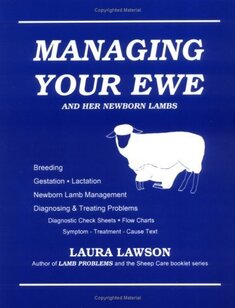 If you follow me on social media, you know I talk about these books A LOT and actually didn't add them to my reading list last year. But they are worth a mention. This one and the book below have been a staple for a few years. Whenever we have a problem, especially during lambing, these are the books I reference. The book is divided between types of issues and each specific topic has a description of symptoms, causes and treatment which I find very helpful for diagnosis. Lamb Problems- Laura Lawson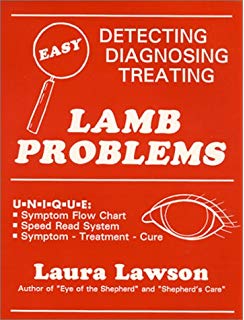 The companion book to the one above, this book focuses specifically on problems with lambs. It is set up similar to the first book with symptoms, causes and treatment and also features a nice flowchart in the back of the book for help with diagnosis. The chart was very helpful in diagnosing a lamb with polio last year. These books are gold! 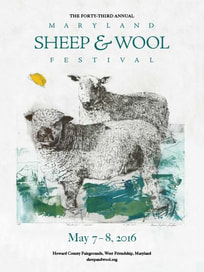 After 15 years of raising sheep, I figured it was about time to get a logo to represent my flock and build my marketing. I couldn't think of anyone better to help me with this project than Victoria Savka! While we completed this project some time ago, I realized I haven't even "officially" introduced it. Victoria and I were introduced by our moms several years ago, who work together at Monroe Community College. We became instant friends who bonded over our love of farm animals (especially sheep), as well as our love for the outdoors, Sunday afternoon hikes and a good bowl of pho. Those of you who are fans of the Maryland Sheep and Wool Festival might recognize Victoria's artwork, as she won the 2016 contest. To MDSW fans like my family, this is a big deal! She has come out to visit my flock several times and has even featured my sheep in several pieces of her artwork. The one below (taken at Corn Hill Art's Festival) features of a couple of my favorite ewes. Victoria's artwork is done using a method called drypoint printmaking, which uses sharp tools to etch onto a hard surface like copper or plexiglass. I love how the images are simple yet detailed and convey the textures of the animals she creates. My breed, the Lincoln Longwool, is known for their long curly locks and I knew my farm logo needed to accentuate that characteristic of the wool. I asked Victoria what she thought about helping me with this process and she eagerly agreed! Being busy people, it was a long process of back and forths. She began by creating some sketches and I picked out which ones I liked and told her why. She then used my feedback to create several more iterations, fine tuning the details and the parts that I liked. We ended by creating a unique, hand lettered font to match the final artwork. I am so excited about my farm logo and began using it in 2019 on my first batch of farm yarn. I can't wait to continue using it for many years to come! And please check out and support Victoria's amazing artwork! Lambing season can be a stressful time for shepherds and not a year goes by that we don't learn something new or have a new problem that needs to be solved. It's important to be prepared for lambing season (and late gestation) to prevent overnight shipping fees and hurried trips to Tractor Supply and Runnings- which we just did yesterday.
Here is a list of some of my lambing essentials and what they are used for. Please don't take this as veterinary advice, but rather tips from a fellow shepherd and things I have learned over 15 years of lambing. Everyone has their own lambing tips, tricks, supplies and ways of doing things. Let me know if there's something else that should be included in my list! Is there something you have found useful that I should also have on hand? Lamb-Specific Supplies 1. Scale & sling- Every lamb is weighed immediately following birth 2. Iodine & surgical scissors- For removing the umbilical cord after birth 3. BoSe & Vitamin E- For lambs with potential white muscle, or perking up weak lambs 4. Gloves (both regular latex & breeding gloves)- For pulling lambs and messy situations 5. Clean towels- For assisting ewes with drying off lambs in cold weather. We like to put in the drier for a few minutes to warm up 6. Colostrum & milk replacer- When the ewe may not be able to provide 7. Pritchard teats & 16 oz soda bottle- For feeding milk if needed 8. Stomach tube- Truthfully I have almost never tubed a lamb in my 15 years of lambing, but others would tell you this needs to be on your list 9. Heat lamps- Helpful on very cold February nights! I really like the new ones from Premier 1 10. Tags/Tagger 11. O-rings/ring expander- For docking tails and castration Ewe-Specific Supplies 1. Nutri-Drench- I give this to any ewe when off feed or seaming weak 2. Vitamin B12- For so many things! 3. Penicillin- For preventing and treating infections 4. Syringes and Needles- I keep mostly 18g x 1" needles on hand and have syringes from 3cc to 20 cc. 5. Drench gun- For giving meds, water, nutri-drench, ANYTHING 6. CalNate/Dextrose/Propylene glycol- For treating ketosis 7. Prolapse retainer and harness- Because at some point a ewe will likely prolapse 8. Uncoated aspirin- For use as a mild painkiller 9. A box or tote for carrying supplies to the barn And last but not least, the books I LIVE by during lambing season: "Managing Your Ewe & Her Newborn Lambs" and "Lamb Problems: Detecting, Diagnosing, Treating" by Laura Lawson I cannot tell you how many ewes and lambs we have saved using these books! They are the most comprehensive and practical veterinary books for sheep that I have found. Her approach sometimes seems like "throw the kitchen sink at them and see what happens", but we have had good luck. There are many other things I have on hand that I've accumulated throughout the years, but this is a good list for someone just starting out and many things I did not have on hand my first few years of lambing. When in doubt- call your vet and have them provide you with the supplies you need. Often, specific items cannot be found at your local Tractor Supply and need to be purchased online at Premier 1 or Valley Vet. I have found that asking questions of other shepherds has been one of the best methods of learning. Happy Lambing! I thought it would be fun to post a photo from each month of this year to highlight and remember all that I've accomplished this year on the farm. It was difficult to choose just one photo for each month. From the most lambs we have ever had, to grazing our newly seeded pasture, to the release of my first farm yarn- 2019 has been a great year for our little flock! To keep up to date with my happenings throughout the year, follow me on Instagram or Facebook: @OrchardViewLincolns. JanuaryLambing began on January 9th and began several months of excitement. FebruaryThis photo is obviously not of my farm, but of a sheep on its way to market in Kenya. I had the opportunity to travel to Kenya in February and saw LOTS of sheep! MarchWe ended the season with 40 lambs- the most ever! AprilLambs on spring pasture. MayAt the Maryland Sheep and Wool Festival, I had the opportunity to have my sheep judged by Ian and Louise of the Risby Flock of Lincolns in the UK. Such an honor and so great to have them here in the US! JuneA VERY wet May and June led to a very lush pasture. It was exciting to see my pasture in full production after seeding last summer. JulyOne of my yearling ewes enjoy a summer evening on pasture. AugustBreeding season was in full swing in August. SeptemberBeautiful fleeces and a pasture full of white clover. OctoberHere is a #nofilter photo for you! There were so many gorgeous sunsets this October. It was hard to choose just one photo. NovemberShearing day in November resulted in some of the highest yielding and highest quality fleeces we have ever had. DecemberDecember means time to stay feeding hay again. Pregnant ewes are preparing for another lambing season.
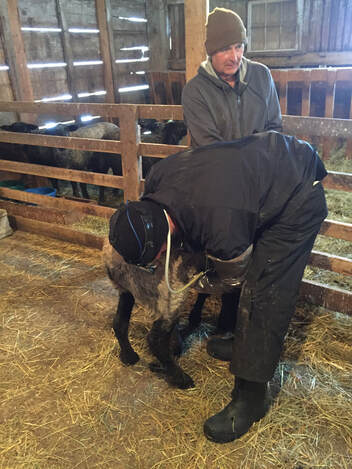 ,The past couple weeks have been filled with pregnancy announcements for both family and friends of mine and Orchard View Farm has an announcement of our own: we will be expecting around 40 lambs starting in January 2020! Yesterday, we had Dr. Andrew from Attica Veterinary Services come to ultrasound my ewes. Last year was the first year we did this and it was very helpful to know which ewes were confirmed pregnant and how many lambs each ewe was expecting. We were even able to save at least one lamb when we realized the ewe had only birthed one, but the ultrasound said she had two. Ultrasounding the sheep is similar to ultrasounding humans. The probe lays against the ewe's belly and the vet then can see the images through a headpiece. They look for images of a head and spine and can often determine the age of the fetus. The vet checks both sides of the ewe to determine whether there are twins. While telling the gender of the lambs is possible, it is difficult with the lamb moving around and it must be positioned correctly. The best time for ultrasounding ewes is 45-90 days of gestation. This year, it appears that we have a 100% conception rate! We will be expecting around 40 lambs with only a few singles and a possible set of triplets (which are more difficult to tell via the ultrasound). Most of the ewes are around 100 days of gestation. A sheep's gestation period is approximately 148 days, meaning that we will be having a very busy few weeks at the end of January. Now that we have confirmed pregnancies that are a month from lambing, it's time to start prepping the barn, our supplies, and ourselves! If all goes as planned, lambs will be ready to be sold and go to their new home beginning in May so contact me if you are interested in lambs for spring 2020. This past weekend was our fall shearing day. I have been looking forward to seeing all my summer fleeces; they look so much better after being outside on pasture all summer than coming out of being in the barn all winter. I was not disappointed!
We sheared all 38 sheep, including yearlings and lambs that did not get sheared in the spring. This means I have over 15 fleeces with 10"+ staple length, and most were stunning! I have decided to not shear my lambs until the fall, and let yearlings go a year after their first shearing to better evaluate the fleece genetics in my flock. It has definitely been useful to see which sheep are able to grow a year of fleeces that remain open and beautiful, without matting. The ewes that are able to grow a dense, lustrous and open fleece will be the ones I keep for breeding. It was not only my long stapled fleeces that I was excited about, but my "normal" fleeces with 6 months of growth. Many of my ewes had fleeces that were 6" or longer since just May! Even Colin (my shearer) commented on the staple length this shearing. The only change we have made is grazing on the new pasture that we seeded last fall. This pasture has a very high percentage of white clover, which adds more protein to the diet than a regular grass pasture, which could've contributed to better fleece growth throughout the spring and summer. Since I started grazing my ewes on pasture with no access to the barn, my fleece quality has improved so much- they have clean, open locks that make skirting a dream! There is no straw, and the dew/rain washes out any dirt. I have lots of orders to start filling, so let the skirting begin! Vacuuming the carpet and changing the sheets are things we do to clean our own houses, but cleaning my sheeps' house (ie. the barn) looks a little bit different! We finally have had the opportunity to do a big clean out this week that involves the tractor, a manure spreader and a some muscles. Cleaning out the barn involves taking down the wooden gates, shuffling the sheep around and putting bucket load after bucket load of manure into the spreader. We are lucky to own enough land that we are able to spread the manure right behind the barn. A local dairy farm rents our fields, so we had to wait for the corn to be chopped off before we could clean the barns this year. The manure spread on the fields will be used as fertilizer for next year's corn crop. We borrow the spreader from a friend down the road, which is very helpful! This job is very muddy (always), very stinky, and a lot of work but looks so good when we are done! I'm not entirely sure the sheep notice a difference, but it makes me feel better knowing they're on a cleaner pack. Half of our barn has a concrete floor and the other half has a dirt floor. Lambing takes place in the half with concrete, so we want to give the sheep enough time to build up a bit of a manure pack to keep the floor warmer in the wintertime. I am SO thankful for my dad who did this project entirely on his own while I was at work during the week. He's a trooper! It looks so much better and we can continue our prep for the winter.
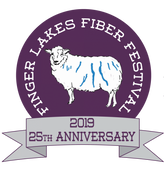 If you weren't at the Purple Pained Lady or the Naples Grape Festival, you might've been at the Finger Lakes Fiber Festival this weekend! Every year in September, fiber artists from around the Rochester area and beyond gather at the Hemlock fairgrounds for the Finger Lakes Fiber Festival. Organized by the Genesee Valley Handspinner's Guild, this festival is a fun time to meet up with other shepherds, fiber artists and old friends. While I have yet to take advantage of the many classes offered, I love to go to pick up some local yarn (as if I need any more...) and catch up with friends I haven't seen in a while. This year I decided to take my grandma and spend the afternoon browsing gorgeous fiber. As I continue to build the fiber side of my business, fiber festivals are a great way to see how others package, display and market their wool. There's a lot to be learned from others and the fiber community is a very caring community who is very willing to talk with me and share ideas. One friend I stopped to talk to was Holly of Peartree Farm. She has beautiful Teeswater sheep that are also a British longwool breed. I went to high school with her kids and it fun to now connect on fiber. She taught me how to spin last winter and has been a great mentor of mine as I begin to delve into the world of fiber. Holly is a talented spinner who makes beautiful art yarns spinning with the locks of her sheep. She recommends "Ideas & Patterns for Art Yarns" and "Unleash Your Inner Design Power" as great books for knitting and creating with art yarns. I would love to do make some of these amazing patterns with my Lincoln Locks. Someday... The other person I enjoyed talking with was Karen of Windsong Wensleydales. Wensleydales are yet another British Longwool breed. Though different than the Lincoln, I loved her display and how she is marketing the beautiful locks. Karen spent a lot of time talking to me about preparing the longwool fleeces for sale and how best to package the roving and locks. I learned so much and am very thankful for the time she spent chatting! We had previously connected through the LocalFiber community in Ithaca and it was great to chat again. I hope to take her up on her offer to come visit and play with wool sometime soon! There were several vendors offering Shave 'Em to Save 'Em passport stickers, which was great to see. If you live in the Western New York area, it's worth checking out this great little fiber festival for beautiful yarns, fibers and classes! Add it to your calendar for next September.
|
AuthorEmmaline Long, main owner of Orchard View Farm, has a passion for Lincoln sheep and loves educating others about her breed and farm, She currently serves as the Vice President of the National Lincoln Breeders Association. Archives
October 2020
Categories
All
|
Orchard View Lincoln Longwools7617 S. Lake Rd., Bergen NY 14416 |
Contact UsStay Up-To-DateFollow our blog!
|
